Why Italy First? Health, Geographical and Planning Aspects of the COVID-19 Outbreak
Abstract
:1. Introduction
1.1. Why Italy (1)? The Epidemiologic Point of View
1.2. Why Italy (2)? The Spatial Point of View
1.3. Air Quality
1.4. Land Take
2. Materials, Data and Methods
2.1. Materials
2.1.1. The Study Area (Italy)
2.1.2. Land Take Phenomenon in Italy
2.1.3. Geography of Diffusion
Diffusion Processes in Geography: Some Theories
COVID-19 Theory and Practice
- A.
- Onset: The ‘innovation’, in the form of a new virus, enters “into a new area with a susceptible population which is open to infection”. Typically, a single location (or a set of limited locations) is involved.
- B.
- Youth: In this step the infection spreads rapidly from its original area to main population centres. Evidences from past outbreaks lead to highlighting both local diffusion (contagion) and long-range ones (hierarchical, cascade).
- C.
- Maturity: The highest intensity is reached with clusters spread over a vulnerable population—the entire areas involved in the epidemic. The intensity is at its maximum with contrasts in infection density in different sub-regions.
- D.
- Decay: Fewer reported cases and decline is registered, with a slower spatial contraction than the proper diffusion steps. Low intensity infected areas appear as scattered.
- E.
- Extinction: The tail of the epidemic wave can be spotted through few and scattered cases, that can be found mostly in less accessible areas.
Diffusion as a Local Spatial Process Before and after the Italian Lockdown
2.2. The Data
2.3. Methods
2.3.1. The Ecological Approach
2.3.2. Calculation of Case Fatality Rate
2.3.3. Calculation of the Standardized Mortality Ratio (SMR)
2.3.4. Spatial Autocorrelation
- i and j are two objects;
- N is the number of objects;
- Cij is a degree of similarity of attributes i and j;
- Wij is a degree of similarity of location i and j;
- locations with high values of the phenomenon and a high level of similarity with its surroundings (high-high H-H), defined as hot spots;
- locations with low values of the phenomenon and a low level of similarity with its surroundings (low-low L-L), defined as cold spots;
- locations with high values of the phenomenon and a low level of similarity with its surroundings (high-low H-L), defined as potentially spatial outliers;
- locations with low values of the phenomenon and a high level of similarity with its surroundings (low-high L-H), defined as potentially spatial outliers;
- locations completely lacking of significant autocorrelations.
3. Results
3.1. Mortality rates, SMRs, Population Density, Commuting
3.2. Local Climate Change and Air Quality
3.3. Land Take and COVID-19
4. Discussion
4.1. Diffusion Processes, Local and Global Effects
4.2. Air Issues and Policies
4.3. New Approaches to Planning and Policies
5. Conclusions
Supplementary Materials
Author Contributions
Funding
Acknowledgments
Conflicts of Interest
Appendix A
| Data/Index | Cov_ | Source | Data Origin | Unit |
|---|---|---|---|---|
| Land take/Soil consumption 2019, total 2014-2018—ha/m2 | 3 | ISPRA 2019 | http://www.isprambiente.gov.it/it/temi/suolo-e-territorio/il-consumo-di-suolo/i-dati-sul-consumo-di-suolo | provincial |
| PM2.5—average yearly values—μg/mc | 14 | ISPRA 2019 | http://www.isprambiente.gov.it/ | urban/periurban |
| PM10—average yearly values—μg/mc | 15 | Il SOLE 24 Ore 2019 | https://lab24.ilsole24ore.com/qualita-della-vita/classifiche-complete.php | urban/periurban |
| Ozone (O3)—days exceeding mobile average on 8 h—120 μg/m3 | 19 | ISPRA 2019 | http://www.isprambiente.gov.it/it/temi/suolo-e-territorio/il-consumo-di-suolo/i-dati-sul-consumo-di-suolo | Urban/periurban |
| COVID-19-Infected | 20 | Ministry of Health (15 April 2020) | http://www.salute.gov.it/imgs/C_17_notizie_4370_1_file.pdf | provincial |
| Ammonia (NH3)—Mg | 25 | ISPRA 2017 | http://www.sinanet.isprambiente.it/it/sia-ispra/inventaria/disaggregazione-dellinventario-nazionale-2015/view | provincial |
| Hospital emigration | 33 | IL SOLE 24 Ore 2019 | https://lab24.ilsole24ore.com/qualita-della-vita/classifiche-complete.php | urban |
| Drugs per capita: asthma, diabetes and hypertension | 70 | IL SOLE 24 Ore 2019 | https://lab24.ilsole24ore.com/qualita-della-vita/classifiche-complete.php | urban |
| Climate well-being index | 37 | IL SOLE 24 Ore 2019 | https://lab24.ilsole24ore.com/indice-del-clima/ | |
| Wind gusts, annual days with gusts> 25 knots | 39 | IL SOLE 24 Ore 2019 | https://lab24.ilsole24ore.com/indice-del-clima/ | urban |
| Fog | 41 | IL SOLE 24 Ore 2019 | https://lab24.ilsole24ore.com/indice-del-clima/ | urban |
| Surface waterproofed to year 2016 | 49 | ISPRA 2019 | provincial | |
| Urbanized areas early 2000s | 52 | Papers By Romano et al. reported in references | ||
| Km/h wind—Il meteo.com Meteo archive—January–February–March 2020 | 55 | IL METEO.it (2020) | http://www.ilmeteo.it | Urban/periurban |
| COVID-19 Deaths | 57 | Different Sources (31 March 2020) | Provincial | |
| COVID-19 Infected | 58 | Ministry of Health (31 March 2020) | http://www.salute.gov.it/imgs/C_17_notizie_4370_1_file.pdf | Regional/provincial |
| Inhabitants/Km2 | 64 | ISTAT 2019 | http://demo.istat.it/pop2019/index3.html?fbclid=IwAR3ZfOAubR1OBU3xD5qvD5FKWMhKW9Cxy1KF68GCZMJxgnIy1SIe4MJlrEI | provincial |
| Lethality | 65 | Ministry of Health (31 March 2020) | http://www.salute.gov.it/imgs/C_17_notizie_4370_1_file.pdf | |
| SMR | 66 | Our elaboration/data from various sources; Ministry of Health | provincial | |
| PM10 + Ozone—overrun days 2017–2019 | 72 | Legambiente (2020) | https://www.legambiente.it/wp-content/uploads/2020/01/Malaria-di-citta-2020.pdf | provincial |
| CO2/non urbanized areas | 82 | |||
| Commuting: OD flows/internal flows | 83 | ISTAT 2011 (census data) | https://www.istat.it/pendolarismo/grafici_province_cartografia_2011.html | provincial |
Appendix B
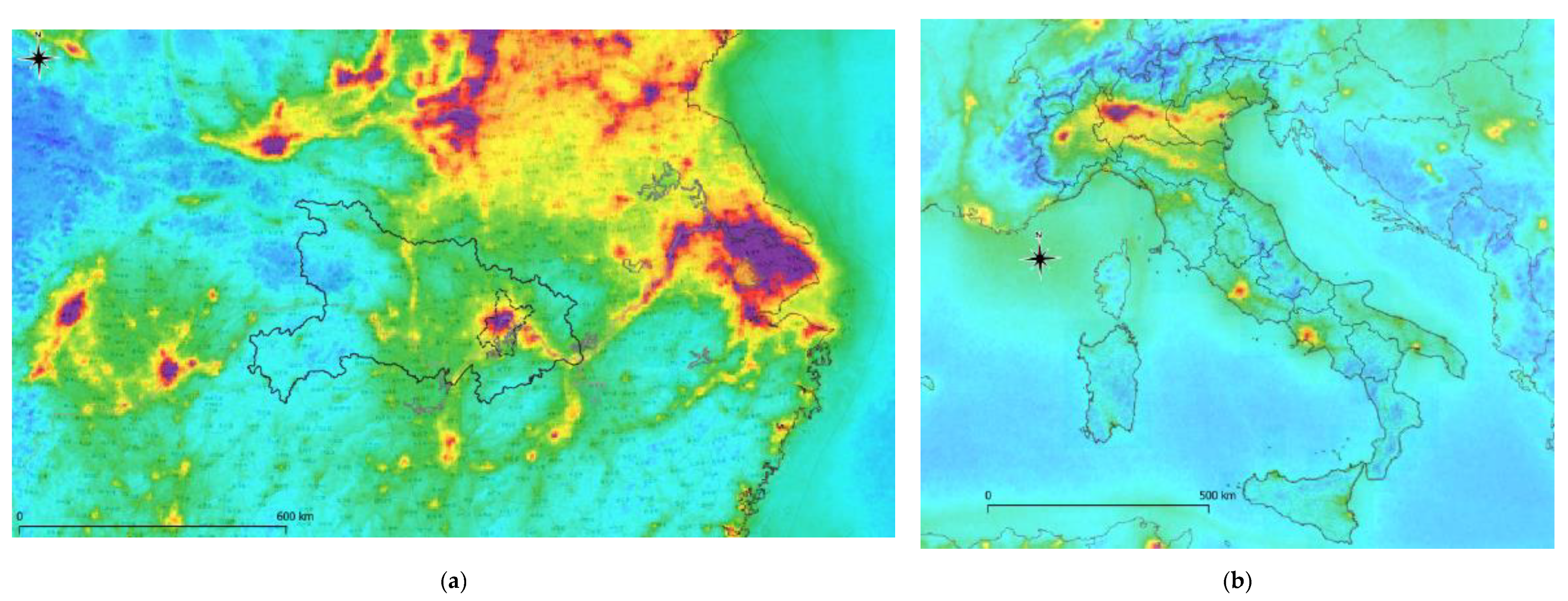
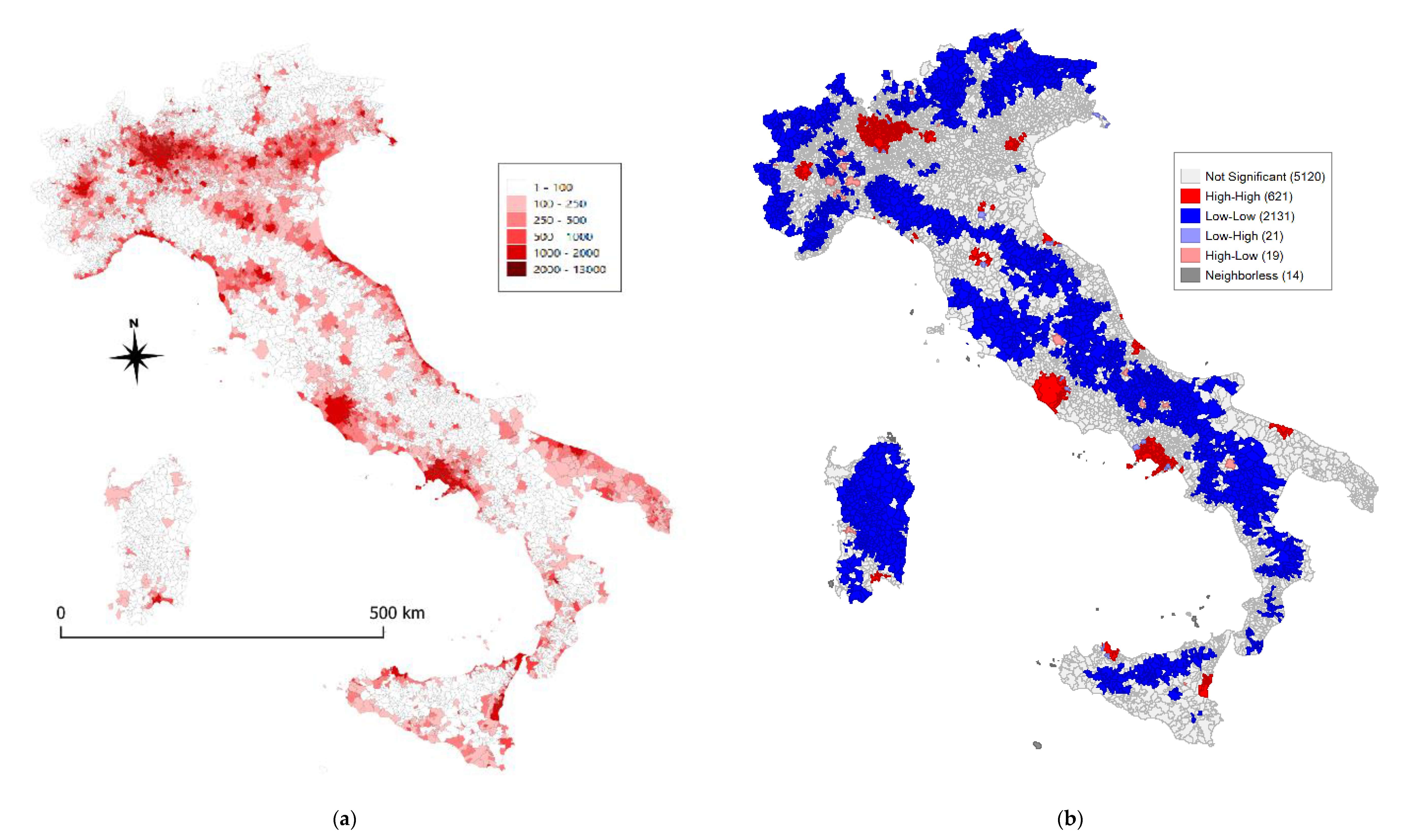

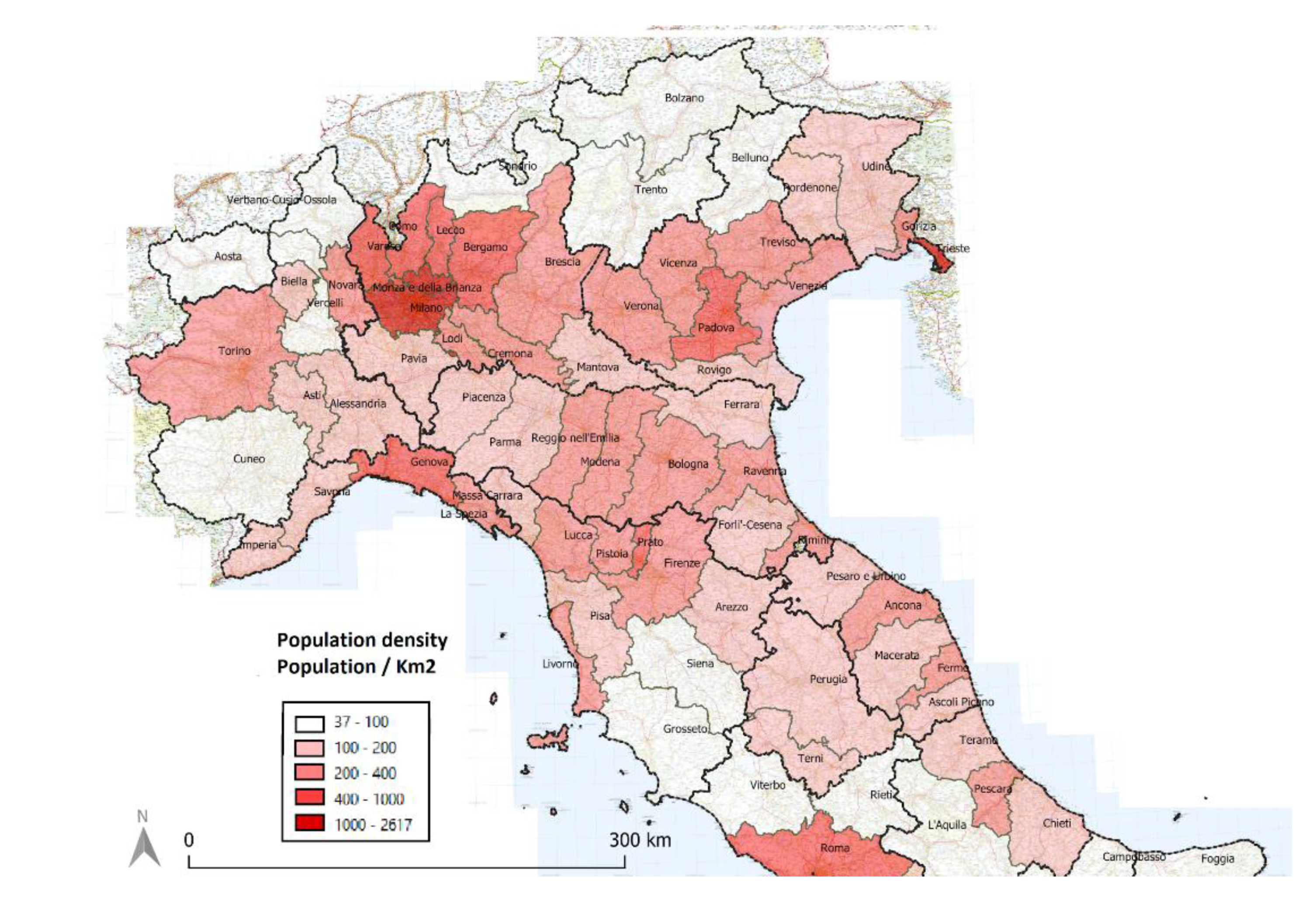
References
- Gorbalenya, A.E.; Baker, S.C.; Baric, R.S.; de Groot, R.J.; Drosten, C.; Gulyaeva, A.A.; Haagmans, B.L.; Lauber, C.; Leontovich, A.M.; Neuman, B.W.; et al. The species Severe acute respiratory syndrome-related coronavirus: Classifying 2019-nCoV and naming it SARS-CoV-2. Nat. Microbiol. 2020, 5, 536–544. [Google Scholar]
- World Health Organization. Coronavirus Disease 2019 (COVID-19) Situation Report-92; World Health Organization: Geneva, Switzerland, 2020. [Google Scholar]
- World Health Organization. Report of the WHO-China Joint Mission on Coronavirus Disease 2019 (COVID-19); World Health Organization: Geneva, Switzerland, 2020. [Google Scholar]
- World Health Organization. Coronavirus Disease 2019 (COVID-19) Situation Report-12; World Health Organization: Geneva, Switzerland, 2020. [Google Scholar]
- Istituto Superiore della Sanità. Report Sulle Caratteristiche dei Pazienti Deceduti Positivi a COVID-19 in Italia Report Basato su dati Aggiornati al 20 Marzo 2020; Istituto Superiore della Sanità: Roma, Italy, 2020. [Google Scholar]
- Istituto Superiore della Sanità. Epidemia COVID-19; Istituto Superiore della Sanità: Roma, Italy, 2020. [Google Scholar]
- Eurostat Population Structure and Ageing. Available online: https://ec.europa.eu/eurostat/statistics-explained/index.php/Population_structure_and_ageing (accessed on 19 April 2020).
- Istituto Cattaneo. La Crescita della Mortalità ai Tempi del Covid-19 Analisi di 1.084 Comuni Italiani; Istituto Cattaneo: Bologna BO, Italy, 2020. [Google Scholar]
- Istituto Nazionale di Statistica. Anziani: Le condizioni di salute in Italia e nell’Unione Europea; Istituto Nazionale di Statistica: Rome, Italy, 2015. [Google Scholar]
- Gurwitz, D. Angiotensin receptor blockers as tentative SARS-CoV-2 therapeutics. Drug Dev. Res. 2020, 21656. [Google Scholar] [CrossRef] [PubMed] [Green Version]
- Agenzia Italiana del Farmaco. Precisazioni AIFA su Malattia da Coronavirus Covid-19 ed Utilizzo di ACE-INIBITORI E SARTANI; Agenzia Italiana del Farmaco: Rome, Italy, 2020. [Google Scholar]
- Rothe, C.; Schunk, M.; Sothmann, P.; Bretzel, G.; Froeschl, G.; Wallrauch, C.; Zimmer, T.; Thiel, V.; Janke, C.; Guggemos, W.; et al. Transmission of 2019-NCOV infection from an asymptomatic contact in Germany. N. Engl. J. Med. 2020, 382, 970–971. [Google Scholar] [CrossRef] [Green Version]
- Van Doremalen, N.; Bushmaker, T.; Morris, D.H.; Holbrook, M.G.; Gamble, A.; Williamson, B.N.; Tamin, A.; Harcourt, J.L.; Thornburg, N.J.; Gerber, S.I.; et al. Aerosol and Surface Stability of SARS-CoV-2 as Compared with SARS-CoV-1. N. Engl. J. Med. 2020. [Google Scholar] [CrossRef]
- Peng, L.; Zhao, X.; Tao, Y.; Mi, S.; Huang, J.; Zhang, Q. The effects of air pollution and meteorological factors on measles cases in Lanzhou, China. Environ. Sci. Pollut. Res. 2020, 27, 13524–13533. [Google Scholar] [CrossRef]
- Chen, J.-C.; Schwartz, J. Metabolic Syndrome and Inflammatory Responses to Long-Term Particulate Air Pollutants. Environ. Health Perspect. 2008, 116, 612–617. [Google Scholar] [CrossRef] [Green Version]
- Conticini, E.; Frediani, B.; Caro, D. Can atmospheric pollution be considered a co-factor in extremely high level of SARS-CoV-2 lethality in Northern Italy? Environ. Pollut. 2020, 261, 114465. [Google Scholar] [CrossRef]
- Mandhana, N.; Solomon, F. Business Meeting at Luxury Singapore Hotel Becomes Latest Coronavirus Focus. Wall Str. J. 2020. [Google Scholar]
- European Space Agency COVID-19: Nitrogen Dioxide Over China. Available online: https://www.esa.int/Applications/Observing_the_Earth/Copernicus/Sentinel-5P/COVID-19_nitrogen_dioxide_over_China (accessed on 22 April 2020).
- European Space Agency Coronavirus: Nitrogen Dioxide Emissions Drop over Italy. Available online: http://www.esa.int/ESA_Multimedia/Videos/2020/03/Coronavirus_nitrogen_dioxide_emissions_drop_over_Italy (accessed on 22 April 2020).
- Skarbit, N.; Ács, F.; Breuer, H. The climate of the European region during the 20th and 21st centuries according to Feddema. Int. J. Climatol. 2018, 38, 2435–2448. [Google Scholar] [CrossRef]
- Huang, Y.; Lu, S.; Yang, X.; Zhao, Z. Exploring Railway Network Dynamics in China from 2008 to 2017. ISPRS Int. J. Geo-Inf. 2018, 7, 320. [Google Scholar] [CrossRef] [Green Version]
- Yu, Y.; He, J.; Tang, W.; Li, C. Modeling Urban Collaborative Growth Dynamics Using a Multiscale Simulation Model for the Wuhan Urban Agglomeration Area, China. ISPRS Int. J. Geo-Inf. 2018, 7, 176. [Google Scholar] [CrossRef] [Green Version]
- Assaeroporti Dati Annuali Traffico Aeroportuale Italiano. Available online: https://assaeroporti.com/dati-annuali/ (accessed on 22 April 2020).
- Romano, B.; Zullo, F.; Fiorini, L.; Marucci, A.; Ciabò, S. Land transformation of Italy due to half a century of urbanization. Land Use Policy 2017, 67, 387–400. [Google Scholar] [CrossRef]
- Pezzagno, M.; Richiedei, A.; Tira, M. Spatial Planning Policy for Sustainability: Analysis Connecting Land Use and GHG Emission in Rural Areas. Sustainability 2020, 12, 947. [Google Scholar] [CrossRef] [Green Version]
- Senes, G.; Fumagalli, N.; Ferrario, P.; Rovelli, R.; Sigon, R. Definition of a Land Quality Index to preserve the best territories from future land take. An application to a study area in Lombardy (Italy). J. Agric. Eng. 2020, 51, 43–55. [Google Scholar] [CrossRef]
- Lu, X.; Chen, D.; Wang, Y. Is urban sprawl decoupled from the quality of economic growth? Evidence from Chinese cities. Sustainability 2020, 12, 218. [Google Scholar] [CrossRef] [Green Version]
- Setti, L.; Rizzo-Società, E.; Medicina, I.; Alessandro, A.; Italiana, M.-S.; Ambientale, M. Relazione Circa L’effetto Dell’inquinamento da Particolato Atmosferico e la Diffusione di Virus Nella Popolazione; Università di Bologna: Bologna, Italy, 2020. [Google Scholar]
- Du, Z.; Lawrence, W.R.; Zhang, W.; Zhang, D.; Yu, S.; Hao, Y. Interactions between climate factors and air pollution on daily HFMD cases: A time series study in Guangdong, China. Sci. Total Environ. 2019, 656, 1358–1364. [Google Scholar] [CrossRef]
- Roussel, I. Extreme Weather Events and Air Pollution Peaks in the Light of Climate Change: The Limits of the Notion of Risk. In Extreme Weather Events and Human Health; Akhtar, R., Ed.; Springer International Publishing: Berlin/Heidelberg, Germany, 2020; pp. 59–78. ISBN 978-3-030-23772-1. [Google Scholar]
- Jacob, D.J.; Winner, D.A. Effect of climate change on air quality. Atmos. Environ. 2009, 43, 51–63. [Google Scholar] [CrossRef] [Green Version]
- Maione, M.; Fowler, D.; Monks, P.S.; Reis, S.; Rudich, Y.; Williams, M.L.; Fuzzi, S. Air quality and climate change: Designing new win-win policies for Europe. Environ. Sci. Policy 2016, 65, 48–57. [Google Scholar] [CrossRef] [Green Version]
- European Environment Agency. Europes Urban Air Quality—Re-Assessing Implementation Challenges in Cities—European Environment Agency EEA Report No 24/2018; European Environment Agency: København, Denmark, 2018. [Google Scholar]
- European Environment. Agency Air quality and COVID-19—European Environment Agency; European Environment Agency: København, Denmark, 2020. [Google Scholar]
- Reames, T.G.; Bravo, M.A. People, place and pollution: Investigating relationships between air quality perceptions, health concerns, exposure, and individual- and area-level characteristics. Environ. Int. 2019, 122, 244–255. [Google Scholar] [CrossRef]
- Mitsakou, C.; Dimitroulopoulou, S.; Heaviside, C.; Katsouyanni, K.; Samoli, E.; Rodopoulou, S.; Costa, C.; Almendra, R.; Santana, P.; Dell’Olmo, M.M.; et al. Environmental public health risks in European metropolitan areas within the EURO-HEALTHY project. Sci. Total Environ. 2019, 658, 1630–1639. [Google Scholar] [CrossRef]
- Chalvatzaki, E.; Chatoutsidou, S.E.; Lehtomäki, H.; Almeida, S.M.; Eleftheriadis, K.; Hänninen, O.; Lazaridis, M. Characterization of human health risks from particulate air pollution in selected European cities. Atmosphere 2019, 10, 96. [Google Scholar] [CrossRef] [Green Version]
- Sofia, D.; Gioiella, F.; Lotrecchiano, N.; Giuliano, A. Mitigation strategies for reducing air pollution. Environ. Sci. Pollut. Res. 2020, 1–10. [Google Scholar] [CrossRef] [PubMed]
- Magnani, N.; Carrosio, G.; Osti, G. Energy retrofitting of urban buildings: A socio-spatial analysis of three mid-sized Italian cities. Energy Policy 2020, 139, 111341. [Google Scholar] [CrossRef]
- Legambiente. Mal’aria di Città; Legambiente: Rome, Italy, 2020. [Google Scholar]
- Blum, J. Contribution of Ecosystem Services to Air Quality and Climate Change Mitigation Policies: The Case of Urban Forests in Barcelona, Spain. In Urban Forests Ecosystem Services and Management; Blum, J., Ed.; Apple Academic Press: New York, NY, USA, 2017; pp. 21–54. ISBN 9781315366081. [Google Scholar]
- Regione Lombardia. Piano Aria Regione Lombardia—Comune di Milano; Regione Lombardia: Milan, Italy, 2018. [Google Scholar]
- Regione Emilia-Romagna. Piano Aria Integrato Regionale (PAIR 2020) dell’Emilia-Romagna; Regione Emilia-Romagna: Bologna, Italy, 2020. [Google Scholar]
- Turri, E. La Megalopoli Padana; Marsilio Editori: Venice, Italy, 2001; ISBN 978-88-317-7556-4. [Google Scholar]
- Brunet, R. Les Villes “Européennes”; La Documentation Française: Paris, France, 1989; ISBN 9782110022004. [Google Scholar]
- AA. VV. Megalopoli Mediterranea. | 598; Muscarà, C., Ed.; FrancoAngeli: Milan, Italy, 1978. [Google Scholar]
- Dematteis, G. Il Fenomeno Urbano in Italia; DeMatteis, G., Ed.; FrancoAngeli: Milan, Italy, 1992. [Google Scholar]
- Boeri, S.; Lanzani, A.; Marini, E. Il Territorio Che Cambia: Ambienti, Paesaggi e Immagini Della Regione Milanese; Abitare Segesta: Lombardy, Italy, 1993; ISBN 8886116179. [Google Scholar]
- Boscacci, F.; Camagni, R. Tra Città e Campagna: Periurbanizzazione e Politiche Territoriali; Il Mulino: Bologna, Italy, 1994; ISBN 8815047816. [Google Scholar]
- Turri, E. Il Paesaggio Degli Uomini: La Natura, la Cultura, la Storia; Zanichelli: Bologna, Italy, 2003; ISBN 9788808072337. [Google Scholar]
- Turco, A. Governance territoriale. Norme, Discorsi, Pratiche; Unicopli: Milan, Italy, 2013; ISBN 9788840016344. [Google Scholar]
- Turco, A. Paesaggio, Luogo, Ambiente. La Configuratività Territoriale Come Bene Comune—A. Turco—Libro—Studi e Ricerche Sul Territorio | IBS; Unicopli: Milan, Italy, 2014; ISBN 9788840017181. [Google Scholar]
- Dagradi, P. PADANA, PIANURA. Encicl. Ital. Treccani Appendice 1994. [Google Scholar]
- ARPA Lombardia. Indice di Qualità Dell’aria—Aria / Qualità dell’Aria; ARPA Lombardia: Milan, Italy, 2019. [Google Scholar]
- ARPA Veneto. QUALITÀ DELL’ARIA—DATI VALIDATI; ARPA Veneto: Padua, Italy, 2019. [Google Scholar]
- European Environment Agency. Urban Sprawl in Europe—The Ignored Challenge—European Environment Agency; European Environment Agency: Luxembourg, 2006. [Google Scholar]
- Romano, B.; Zullo, F. The urban transformation of Italy’s Adriatic coastal strip: Fifty years of unsustainability. Land Use Policy 2014, 38, 26–36. [Google Scholar] [CrossRef]
- Romano, B.; Zullo, F. Half a century of urbanization in southern European lowlands: A study on the Po Valley (Northern Italy). Urban Res. Pract. 2016, 9, 109–130. [Google Scholar] [CrossRef]
- Romano, B.; Zullo, F. Land urbanization in Central Italy: 50 years of evolution. J. Land Use Sci. 2014, 9, 143–164. [Google Scholar] [CrossRef]
- Geneletti, D. Assessing the impact of alternative land-use zoning policies on future ecosystem services. Environ. Impact Assess. Rev. 2013, 40, 25–35. [Google Scholar] [CrossRef]
- Geneletti, D. Ecosystem services for Strategic Environmental Assessment: Concepts and examples. In Handbook on Biodiversity and Ecosystem Services in Impact Assessment; Geneletti, D., Ed.; Edward Elgar Publishing: Cheltenham, UK, 2016; pp. 41–61. ISBN 978 1 78347 898 9. [Google Scholar]
- Sallustio, L.; Munafò, M.; Riitano, N.; Lasserre, B.; Fattorini, L.; Marchetti, M. Integration of land use and land cover inventories for landscape management and planning in Italy. Environ. Monit. Assess. 2016, 188, 1–20. [Google Scholar] [CrossRef]
- European Commission. Guidelines on Best Practice to Limit, Mitigate or Compensate Soil Sealing. European Commission: Bruxelles, Belgium, 2012. [Google Scholar]
- Munafò, M.; Salvati, L.; Zitti, M. Estimating soil sealing rate at national level—Italy as a case study. Ecol. Indic. 2013, 26, 137–140. [Google Scholar] [CrossRef]
- Lawler, J.J.; Lewis, D.J.; Nelson, E.; Plantinga, A.J.; Polasky, S.; Withey, J.C.; Helmers, D.P.; Martinuzzi, S.; Penningtonh, D.; Radeloff, V.C. Projected land-use change impacts on ecosystem services in the United States. Proc. Natl. Acad. Sci. USA 2014, 111, 7492–7497. [Google Scholar] [CrossRef] [PubMed] [Green Version]
- Geneletti, D.; Biasiolli, A.; Morrison-Saunders, A. Land take and the effectiveness of project screening in Environmental Impact Assessment: Findings from an empirical study. Environ. Impact Assess. Rev. 2017, 67, 117–123. [Google Scholar] [CrossRef]
- Zomer, R.J.; Bossio, D.A.; Sommer, R.; Verchot, L.V. Global Sequestration Potential of Increased Organic Carbon in Cropland Soils. Sci. Rep. 2017, 7, 1–8. [Google Scholar] [CrossRef] [PubMed] [Green Version]
- Manes, F.; Marando, F.; Capotorti, G.; Blasi, C.; Salvatori, E.; Fusaro, L.; Ciancarella, L.; Mircea, M.; Marchetti, M.; Chirici, G.; et al. Regulating Ecosystem Services of forests in ten Italian Metropolitan Cities: Air quality improvement by PM10 and O3 removal. Ecol. Indic. 2016, 67, 425–440. [Google Scholar] [CrossRef]
- Fusaro, L.; Marando, F.; Sebastiani, A.; Capotorti, G.; Blasi, C.; Copiz, R.; Congedo, L.; Munafò, M.; Ciancarella, L.; Manes, F. Mapping and Assessment of PM10 and O3 Removal by Woody Vegetation at Urban and Regional Level. Remote Sens. 2017, 9, 791. [Google Scholar] [CrossRef] [Green Version]
- Salvati, L.; Munafo, M.; Morelli, V.G.; Sabbi, A. Low-density settlements and land use changes in a Mediterranean urban region. Landsc. Urb. Plan. 2012, 105, 43–52. [Google Scholar] [CrossRef]
- Romano, B.; Zullo, F.; Fiorini, L.; Ciabò, S.; Marucci, A. Sprinkling: An Approach to Describe Urbanization Dynamics in Italy. Sustainability 2017, 9, 97. [Google Scholar] [CrossRef] [Green Version]
- Saganeiti, L.; Favale, A.; Pilogallo, A.; Scorza, F.; Murgante, B. Assessing urban fragmentation at regional scale using sprinkling indexes. Sustainability 2018, 10, 3274. [Google Scholar] [CrossRef] [Green Version]
- Camagni, R.; Gibelli, M.C.; Rigamonti, P. Urban mobility and urban form: The social and environmental costs of different patterns of urban expansion. Ecol. Econ. 2002, 40, 199–216. [Google Scholar] [CrossRef]
- Manganelli, B.; Murgante, B.; Saganeiti, L. The Social Cost of Urban Sprinkling. Sustainability 2020, 12, 2236. [Google Scholar] [CrossRef] [Green Version]
- Hagerstrand, T. Innovation Diffusion as a Spatial Process; The University of Chicago Press: Chicago, IL, USA; London, UK, 1967. [Google Scholar]
- Gould, P.R. Spatial Diffusion. In Association of American Geographers; Association of American Geographers: Washington, DC, USA, 1969. [Google Scholar]
- Morrill, R.L. The Shape of Diffusion in Space and Time. Econ. Geogr. 1970, 46, 259. [Google Scholar] [CrossRef]
- Morrill, R. Hägerstrand and the ‘quantitative revolution’: A personal appreciation. Prog. Hum. Geogr. 2005, 29, 333–336. [Google Scholar] [CrossRef] [Green Version]
- FlightConnections—All flights worldwide on a map! Available online: https://www.flightconnections.com/ (accessed on 26 April 2020).
- Cliff, A.D.; Haggett, P. A swash-backwash model of the single epidemic wave. J. Geogr. Syst. 2006, 8, 227–252. [Google Scholar] [CrossRef] [PubMed] [Green Version]
- Haggett, P.; Cliff, A. The Geography of Disease Distributions. In A Century of British Geography. Johnston, R., Williams, M., Eds.; Oxford University Press: Oxford, UK, 2003; pp. 521–543. ISBN 0197262864. [Google Scholar]
- Haggett, P.; Cliff, A. Modeling diffusion processes. In Encyclopaedia of Social Measurement; Kempf-Leonard, K., Ed.; Elsevier Ltd.: Amsterdam, The Netherlands, 2005; Volume 2, pp. 709–724. ISBN 0124366430. [Google Scholar]
- Matthew, S.-R.; Peter, H.; Andrew, C. World Atlas of Epidemic Diseases; CRC Press: Boca Raton, FL, USA, 2004; ISBN 9780429072499. [Google Scholar]
- Cliff, A.; Haggett, P.; Smallman-Raynor, M. Deciphering Global Epidemics; Cambridge University Press: Cambridge, UK, 1998. [Google Scholar]
- Cliff, A.D.; Haggett, P.; Smallman-Raynor, M. An exploratory method for estimating the changing speed of epidemic waves from historical data. Int. J. Epidemiol. 2008, 37, 106–112. [Google Scholar] [CrossRef] [Green Version]
- Haggett, P. Geography:A Global Synthesis; Hall, P., Ed.; Pearson Education: London, UK, 2001. [Google Scholar]
- Cliff, A.D.; Andrew, D.; Haggett, P.; Smallman-Raynor, M. Island Epidemics. Oxford University Press: Oxford, UK, 2000; ISBN 9780198288954. [Google Scholar]
- Tatem, A.J.; Rogers, D.J.; Hay, S.I. Global Transport Networks and Infectious Disease Spread. Adv. Parasitol. 2006, 62, 293–343. [Google Scholar] [CrossRef]
- Ben-Zion, Y.; Cohen, Y.; Shnerb, N.M. Modeling epidemics dynamics on heterogenous networks. J. Theor. Biol. 2010, 264, 197–204. [Google Scholar] [CrossRef]
- Bowen, J.T., Jr.; Laroe, C. Airline Networks and the International Diffusion of Severe Acute Respiratory Syndrome. Geogr. J. 2006, 172, 130–144. [Google Scholar] [CrossRef]
- Brockmann, D.; Helbing, D. The hidden geometry of complex, network-driven contagion phenomena. Science 2013, 342, 1337–1342. [Google Scholar] [CrossRef] [Green Version]
- Zhang, L.; Wilson, D.P. Trends in Notifiable Infectious Diseases in China: Implications for Surveillance and Population Health Policy. PLoS ONE 2012, 7, e31076. [Google Scholar] [CrossRef]
- Direct Flights from Wuhan (WUH). Available online: https://www.flightconnections.com/flights-from-wuhan-wuh (accessed on 28 April 2020).
- Eurostat. Energy and Transport in Figures; Eurostat: Luxembourg, 2019. [Google Scholar]
- Borruso, G. A nodal regional analysis of air passenger transport in Europe. Int. J. Bus. Intell. Data Min. 2013, 8, 377–396. [Google Scholar] [CrossRef]
- Koch-Institut, R. Epidemiologisches Bulletin FSME; Risikogebiete in Deutschland: Berlin, Germany, 2020. [Google Scholar]
- Backer, J.A.; Klinkenberg, D.; Wallinga, J. Incubation period of 2019 novel coronavirus (2019-nCoV) infections among travellers from Wuhan, China, 20–28 January 2020. Eurosurveillance 2020, 25, 2000062. [Google Scholar] [CrossRef] [PubMed] [Green Version]
- Lauer, S.A.; Grantz, K.H.; Bi, Q.; Jones, F.K.; Zheng, Q.; Meredith, H.R.; Azman, A.S.; Reich, N.G.; Lessler, J. The Incubation Period of Coronavirus Disease 2019 (COVID-19) From Publicly Reported Confirmed Cases: Estimation and Application. Ann. Intern. Med. 2020. [Google Scholar] [CrossRef] [Green Version]
- Mazzaracca, R. COVID-19: Nuovo Studio sull’incubazione del SARS-CoV-2—Osservatorio Malattie Rare. Available online: https://www.osservatoriomalattierare.it/news/ricerca-scientifica/15771-covid-19-nuovo-studio-sull-incubazione-del-sars-cov-2 (accessed on 20 April 2020).
- Worldometer Coronavirus Incubation Period (COVID-19). Available online: https://www.worldometers.info/coronavirus/coronavirus-incubation-period/ (accessed on 26 April 2020).
- Openshaw, S. The Modifiable Areal Unit Problem; Geo Books: Norwick, UK, 1983; ISBN 0860941345. [Google Scholar]
- Cressie, N.A. Change of support and the modifiable areal unit problem. Geogr. Syst. 1996, 3, 159–180. [Google Scholar]
- Unwin, D.J. GIS, spatial analysis and spatial statistics. Prog. Hum. Geogr. 1996, 20, 540–551. [Google Scholar] [CrossRef]
- O’Sullivan, D.; Unwin, D.J. Geographic Information Analysis: Second Edition; John Wiley and Sons: Hoboken, NJ, USA, 2010; ISBN 9780470288573. [Google Scholar]
- Zhang, J. Soil Environmental Deterioration and Ecological Rehabilitation. In Study of Ecological Engineering of Human Settlements; Springer: Singapore, 2020; pp. 41–82. [Google Scholar]
- Haines-Young, R.; Potschin, M. The links between biodiversity, ecosystem services and human well-being. In Ecosystem Ecology; Raffaelli, D.G., Frid, C.L.J., Eds.; Cambridge University Press: Cambridge, UK, 2010; pp. 110–139. [Google Scholar]
- Charles, M.; Ziv, G.; Bohrer, G.; Bakshi, B.R. Connecting air quality regulating ecosystem services with beneficiaries through quantitative serviceshed analysis. Ecosyst. Serv. 2020, 41, 101057. [Google Scholar] [CrossRef]
- Scorza, F.; Pilogallo, A.; Saganeiti, L.; Murgante, B.; Pontrandolfi, P. Comparing the territorial performances of Renewable Energy Sources’ plants with an integrated Ecosystem Services loss assessment: A case study from the Basilicata region (Italy). Sustain. Cities Soc. 2020, 56, 102082. [Google Scholar] [CrossRef]
- Gatrell, A.C.; Elliott, S.J. Geographies of health: An introduction; Routledge: New York, NY, USA, 2002; ISBN 9780470672877. [Google Scholar]
- Istituto Nazionale di Statistica Statistiche Demografiche ISTAT. Available online: http://demo.istat.it/pop2019/index.html (accessed on 30 April 2020).
- Vandenbroucke, J.P. A shortcut method for calculating the 95 per cent confidence interval of the standardized mortality ratio. Am. J. Epidemiol. 1982, 115, 303–304. [Google Scholar] [CrossRef]
- Goodchild Spatial Autocorrelation, Concepts and Techniques in Modern Geography; Geo Books: Norwich, UK, 1986.
- Tobler, W.R. A Computer Movie Simulating Urban Growth in the Detroit Region. Econ. Geogr. 1970, 46, 234. [Google Scholar] [CrossRef]
- Tobler, W. On the first law of geography: A reply. Ann. Assoc. Am. Geogr. 2004, 94, 304–310. [Google Scholar] [CrossRef]
- Sui, D.Z. Tobler’s first law of geography: A big idea for a small world? Ann. Assoc. Am. Geogr. 2004, 94, 269–277. [Google Scholar] [CrossRef]
- Lee, J.; Wong, D.W.S.; David, W.-S. GIS and Statistical Analysis with ArcView; John Wiley: Hoboken, NJ, USA, 2000; ISBN 0471348740. [Google Scholar]
- Geary, R.C. The Contiguity Ratio and Statistical Mapping. Inc. Stat. 1954, 5, 115. [Google Scholar] [CrossRef]
- Moran, P.A.P. The Interpretation of Statistical Maps. J. R. Stat. Soc. Ser. B 1948, 10, 243–251. [Google Scholar] [CrossRef]
- Murgante, B.; Borruso, G. Analyzing migration phenomena with spatial autocorrelation techniques. In Lecture Notes in Computer Science; Including subseries Lecture Notes in Artificial Intelligence and Lecture Notes in Bioinformatics; Springer: Berlin/Heidelberg, Germany, 2012; Volume 7334 LNCS, pp. 670–685. [Google Scholar]
- Anselin, L. Spatial Econometrics: Methods and Models; Springer: Dordrecht, The Netherlands, 1988; ISBN 978-90-481-8311-1. [Google Scholar]
- Anselin, L. Local Indicators of Spatial Association—LISA. Geogr. Anal. 1995, 27, 93–115. [Google Scholar] [CrossRef]
- Cliff, A.D.; Ord, J.K. The Problem of Spatial Autocorrelation. In Studies in Regional Science; Scott, A.J., Ed.; Pion: London, UK, 1969; pp. 25–55. [Google Scholar]
- World’s Most Polluted Cities in 2019—PM2.5 Ranking | AirVisual. Available online: https://www.iqair.com/world-most-polluted-cities?continent=59af92ac3e70001c1bd78e52&country=wS4BTBZsKwcpavTvr&state=ZYNquGE3EZNSCoq89&page=1&perPage=50&cities= (accessed on 28 April 2020).
- World Health Organization. WHO Air Quality Guidelines for Particulate Matter, Ozone, Nitrogen Dioxide and Sulfur Dioxide; World Health Organization: Geneva, Switzerland, 2006. [Google Scholar]
- European Environment Agency. Emissions of Primary PM2.5 and PM10 Particulate Matter; European Environment Agency: København, Denmark, 2018. [Google Scholar]
- ARPA Lombardia. Qualità Dell’aria: In Lombardia Calano i Livelli di Pm10; Supera ARPA: Milan, Italy, 2020. [Google Scholar]
- Ronchi Fabrizio Tucci, E.; Bailo Modesti, A.; Parasacchi, A.; Barbabella, A.; Leoni, S.; Ciuffini, M.; Dodaro, G.; Cancelli, D.; Refrigeri, L.; Pettinao, E.; et al. Studio Realizzato dal Green City Network e dalla Fondazione per lo Sviluppo Sostenibile; Autori Hanno Collaborato Alla Sezione “Pandemia E Alcune Sfide Delle Green City; Studio realizzato dal Green City Network: Rome, Italy, 2020. [Google Scholar]
- Italy for Climate. 10 Key Trend Sul Clima—I Dati 2019 In Anteprima Per L’italia; Italy for Climate: Rome, Italy, 2019. [Google Scholar]
- Ferrero, L.; Riccio, A.; Ferrini, B.S.; D’Angelo, L.; Rovelli, G.; Casati, M.; Angelini, F.; Barnaba, F.; Gobbi, G.P.; Cataldi, M.; et al. Satellite AOD conversion into ground PM10, PM2.5 and PM1 over the Po valley (Milan, Italy) exploiting information on aerosol vertical profiles, chemistry, hygroscopicity and meteorology. Atmos. Pollut. Res. 2019, 10, 1895–1912. [Google Scholar] [CrossRef]
- Munafò, M. (Ed.) Consumo di Suolo, Dinamiche Territoriali e Servizi Ecosistemici; ISPRA: Rome, Italy, 2019. [Google Scholar]
- Martellozzo, F.; Amato, F.; Murgante, B.; Clarke, K.C. Modelling the impact of urban growth on agriculture and natural land in Italy to 2030. Appl. Geogr. 2018, 91. [Google Scholar] [CrossRef] [Green Version]
- Pileri, P.; Maggi, M. Sustainable planning? First results in land uptakes in rural, natural and protected areas: The Lombardia case study (Italy). J. Land Use Sci. 2010, 5, 105–122. [Google Scholar] [CrossRef]
- Romano, B.; Zullo, F.; Marucci, A.; Fiorini, L. Vintage Urban Planning in Italy: Land Management with the Tools of the Mid-Twentieth Century. Sustainability 2018, 10, 4125. [Google Scholar] [CrossRef] [Green Version]
- Scorza, F.; Saganeiti, L.; Pilogallo, A.; Murgante, B. Ghost Planning: The inefficiency of energy sector policies in a low population density region. Arch. DI Stud. URBANI E Reg. 2020, in press. [Google Scholar]
- Amato, F.; Maimone, B.A.; Martellozzo, F.; Nolé, G.; Murgante, B. The effects of urban policies on the development of urban areas. Sustainability 2016, 8, 297. [Google Scholar] [CrossRef] [Green Version]
- Manganelli, B.; Murgante, B. The dynamics of urban land rent in Italian regional capital cities. Land 2017, 6, 54. [Google Scholar] [CrossRef] [Green Version]
- Cosentino, C.; Amato, F.; Murgante, B. Population-Based Simulation of Urban Growth: The Italian Case Study. Sustainability 2018, 10, 4838. [Google Scholar] [CrossRef] [Green Version]
- Scardaccione, G.; Scorza, F.; Casas, G.L.; Murgante, B. Spatial Autocorrelation Analysis for the Evaluation of Migration flows: The Italian Case; Springer: Berlin/Heidelberg, Germany, 2010; Volume 6016, ISBN 3642121551. [Google Scholar]
- La qualità dell’aria in Emilia-Romagna. Edizione 2018 | Aria | Arpae. Available online: https://www.arpae.it/dettaglio_documento.asp?id=7361&idlivello=134 (accessed on 30 April 2020).
- Bo, M.; Mercalli, L.; Pognant, F.; Cat Berro, D.; Clerico, M. Urban air pollution, climate change and wildfires: The case study of an extended forest fire episode in northern Italy favoured by drought and warm weather conditions. In Energy Reports; Elsevier Ltd.: Amsterdam, The Netherlands, 2020; Volume 6, pp. 781–786. [Google Scholar]
- Wang, P.; Chen, K.; Zhu, S.; Wang, P.; Zhang, H. Severe air pollution events not avoided by reduced anthropogenic activities during COVID-19 outbreak. Resour. Conserv. Recycl. 2020, 158, 104814. [Google Scholar] [CrossRef] [PubMed]
- Romano, B.; Fiorini, L.; Di Dato, C.; Tomei, V. Latitudinal Gradient in Urban Pressure and Socio-Environmental Quality: The “Peninsula Effect” in Italy. Land 2020, 9, 126. [Google Scholar] [CrossRef] [Green Version]
- Gobattoni, F.; Pelorosso, R.; Piccinni, A.F.; Leone, A. UPLanD Journal of Urban Planning, Landscape &Amp; Environmental Design; Federico II Open Access University Press: Naples, Italy, 2016; Volume 2. [Google Scholar]
- Pelorosso, R.; Gobattoni, F.; Leone, A. The low-entropy city: A thermodynamic approach to reconnect urban systems with nature. Landsc. Urban Plan. 2017, 168, 22–30. [Google Scholar] [CrossRef]
- Picchi, P.; van Lierop, M.; Geneletti, D.; Stremke, S. Advancing the relationship between renewable energy and ecosystem services for landscape planning and design: A literature review. Ecosyst. Serv. 2019, 35, 241–259. [Google Scholar] [CrossRef]
- Botequilha-Leitão, A.; Díaz-Varela, E.R. Performance Based Planning of complex urban social-ecological systems: The quest for sustainability through the promotion of resilience. Sustain. Cities Soc. 2020, 56, 102089. [Google Scholar] [CrossRef]
- Baker, D.C.; Sipe, N.G.; Gleeson, B.J. Performance-Based Planning. J. Plan. Educ. Res. 2006, 25, 396–409. [Google Scholar] [CrossRef]
- Frew, T.; Baker, D.; Donehue, P. Performance based planning in Queensland: A case of unintended plan-making outcomes. Land Use Policy 2016, 50, 239–251. [Google Scholar] [CrossRef]
- Marwedel, J. Opting for Performance: An Alternative to Conventional Zoning for Land Use Regulation. J. Plan. Lit. 1998, 13, 220–231. [Google Scholar] [CrossRef]
- Janin Rivolin, U. Conforming and Performing Planning Systems in Europe: An Unbearable Cohabitation. Plan. Pract. Res. 2008, 23, 167–186. [Google Scholar] [CrossRef] [Green Version]
- Pappalardo, V.; La Rosa, D. Policies for sustainable drainage systems in urban contexts within performance-based planning approaches. Sustain. Cities Soc. 2020, 52, 101830. [Google Scholar] [CrossRef]
- La Rosa, D.; Pappalardo, V. Planning for spatial equity—A performance based approach for sustainable urban drainage systems. Sustain. Cities Soc. 2020, 53, 101885. [Google Scholar] [CrossRef]
- Geneletti, D.; La Rosa, D.; Spyra, M.; Cortinovis, C. A review of approaches and challenges for sustainable planning in urban peripheries. Landsc. Urban Plan. 2017, 165, 231–243. [Google Scholar] [CrossRef]
- Steinitz, C. A Framework for Geodesign: Changing Geography by Design; Esri: Redlands, CA, USA, 2012; ISBN 1589483332. [Google Scholar]
- Cocco, C.; Freitas, C.R.; Moura, A.C.M.; Campagna, M. Geodesign process analytics: Focus on design as a process and its outcomes. Sustainability 2020, 12, 119. [Google Scholar] [CrossRef] [Green Version]
- Cocco, C.; Jankowski, P.; Campagna, M. An Analytic Approach to Understanding Process Dynamics in Geodesign Studies. Sustainability 2019, 11, 4999. [Google Scholar] [CrossRef] [Green Version]
- Ronchi, S.; Arcidiacono, A.; Pogliani, L. Integrating green infrastructure into spatial planning regulations to improve the performance of urban ecosystems. Insights from an Italian case study. Sustain. Cities Soc. 2020, 53, 101907. [Google Scholar] [CrossRef]
- Lai, S.; Leone, F.; Zoppi, C. Implementing Green Infrastructures beyond Protected Areas. Sustainability 2018, 10, 3544. [Google Scholar] [CrossRef] [Green Version]
- Cannas, I.; Lai, S.; Leone, F.; Zoppi, C. Integrating Green Infrastructure and Ecological Corridors: A Study Concerning the Metropolitan Area of Cagliari (Italy); Springer: Cham, Switzerland, 2018; pp. 127–145. [Google Scholar]
- Pietrapertosa, F.; Salvia, M.; De Gregorio Hurtado, S.; D’Alonzo, V.; Church, J.M.; Geneletti, D.; Musco, F.; Reckien, D. Urban climate change mitigation and adaptation planning: Are Italian cities ready? Cities 2019, 91, 93–105. [Google Scholar] [CrossRef]
- Uittenbroek, C.J.; Janssen-Jansen, L.B.; Runhaar, H.A.C. Mainstreaming climate adaptation into urban planning: Overcoming barriers, seizing opportunities and evaluating the results in two Dutch case studies. Reg. Environ. Chang. 2013, 13, 399–411. [Google Scholar] [CrossRef]
- Maragno, D.; Dalla Fontana, M.; Musco, F. Mapping Heat Stress Vulnerability and Risk Assessment at the Neighborhood Scale to Drive Urban Adaptation Planning. Sustainability 2020, 12, 1056. [Google Scholar] [CrossRef] [Green Version]
- Giovanetti, M.; Angeletti, S.; Benvenuto, D.; Ciccozzi, M. A doubt of multiple introduction of SARS-CoV-2 in Italy: A preliminary overview. J. Med. Virol. 2020. [Google Scholar] [CrossRef] [PubMed]
- Sandu, A. ISOCARP International Meeting for Creating the First Romanian Delegation at ISOCARP; Elisei, P., Ed.; ISOCARP—International Society of City and Regional Planners: Rome, Italy, 2011. [Google Scholar]
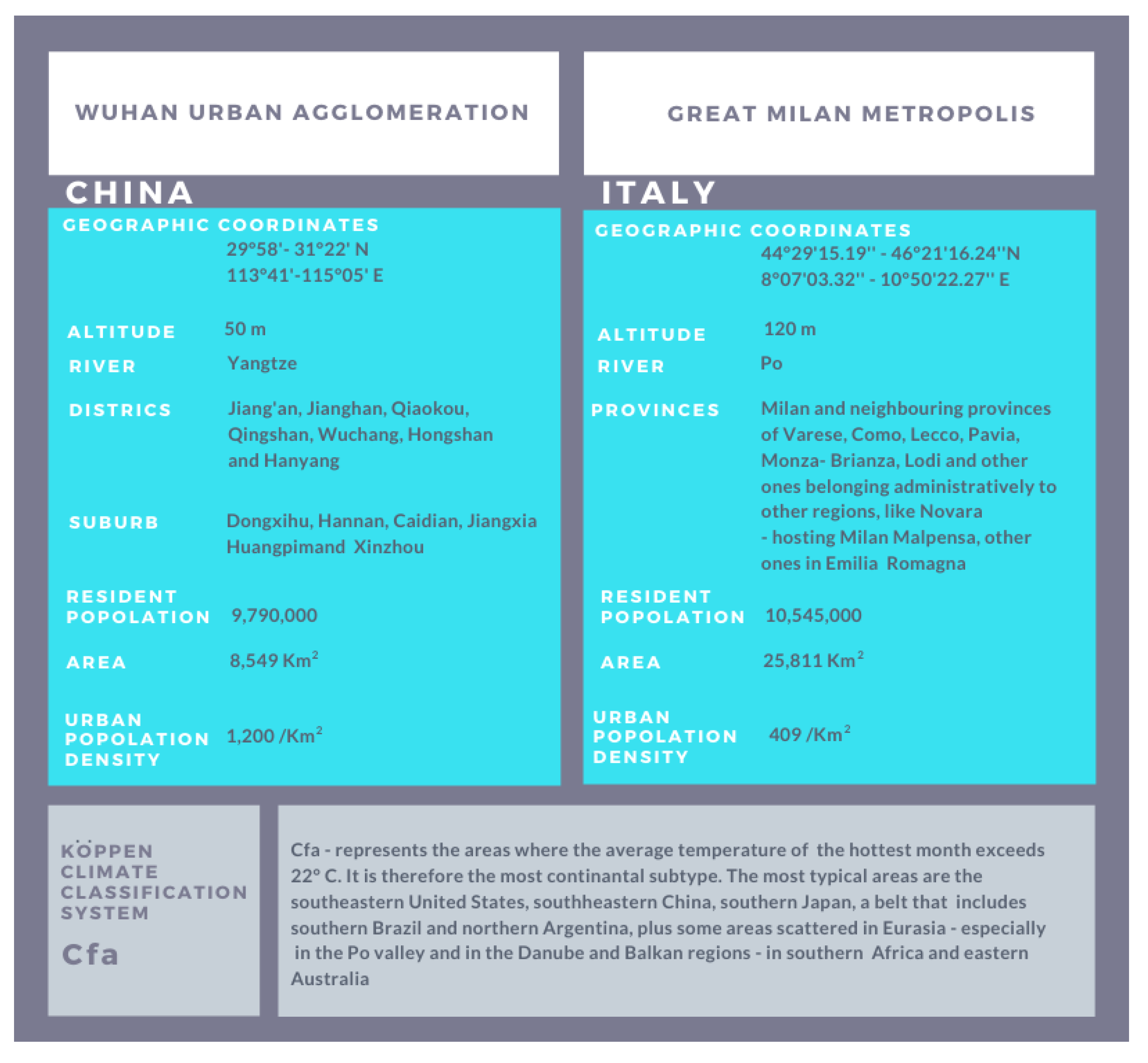
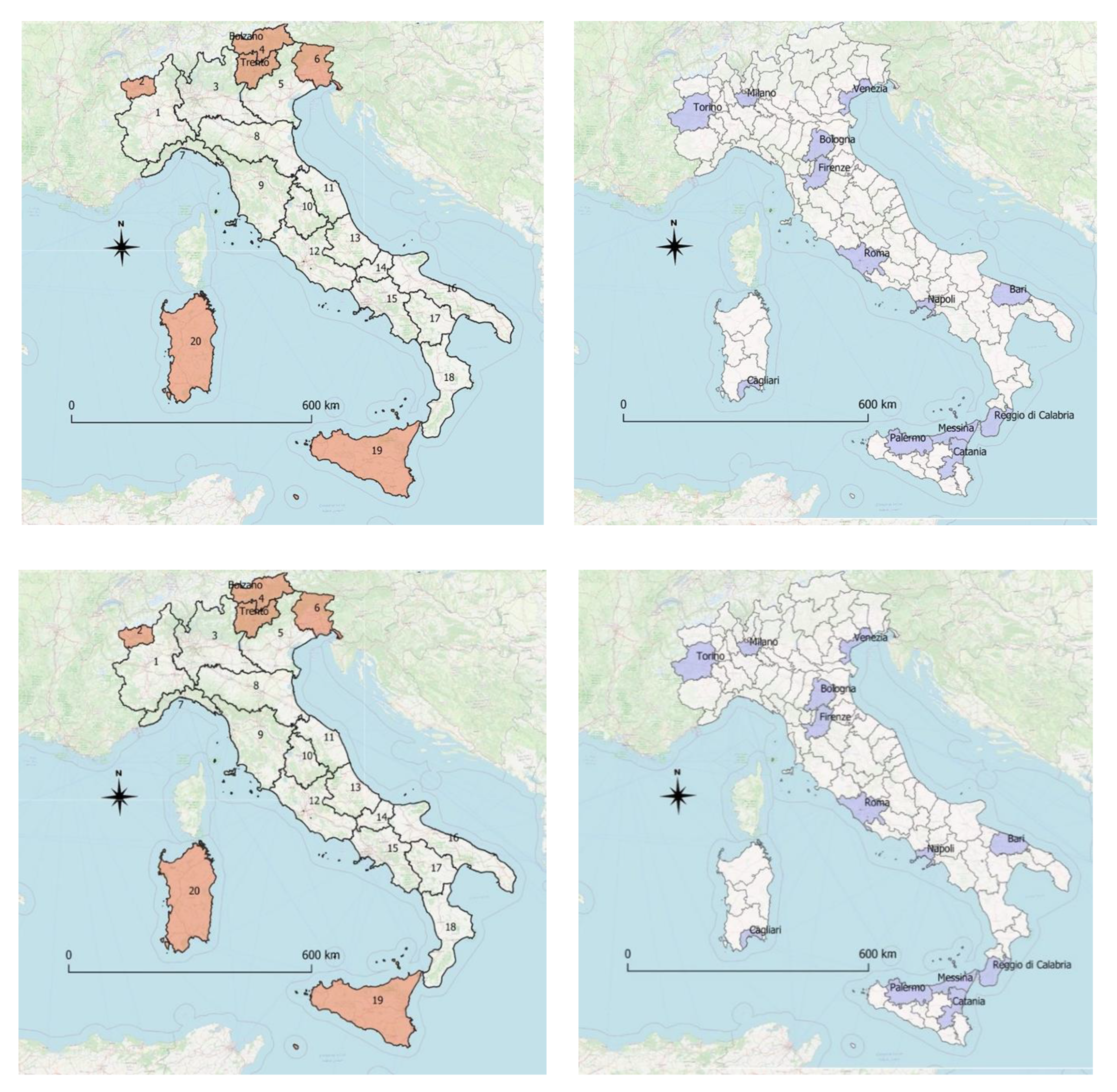
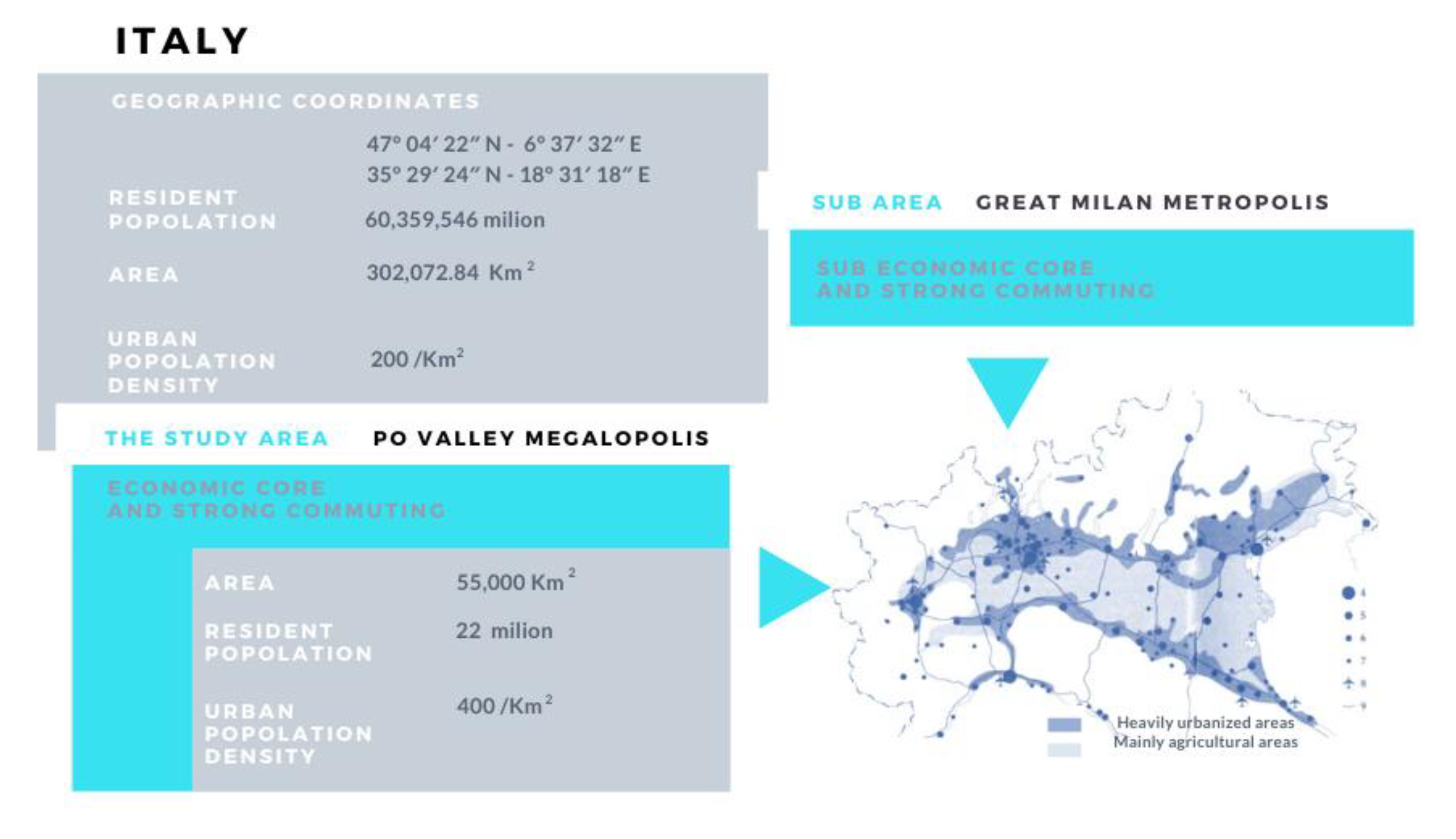

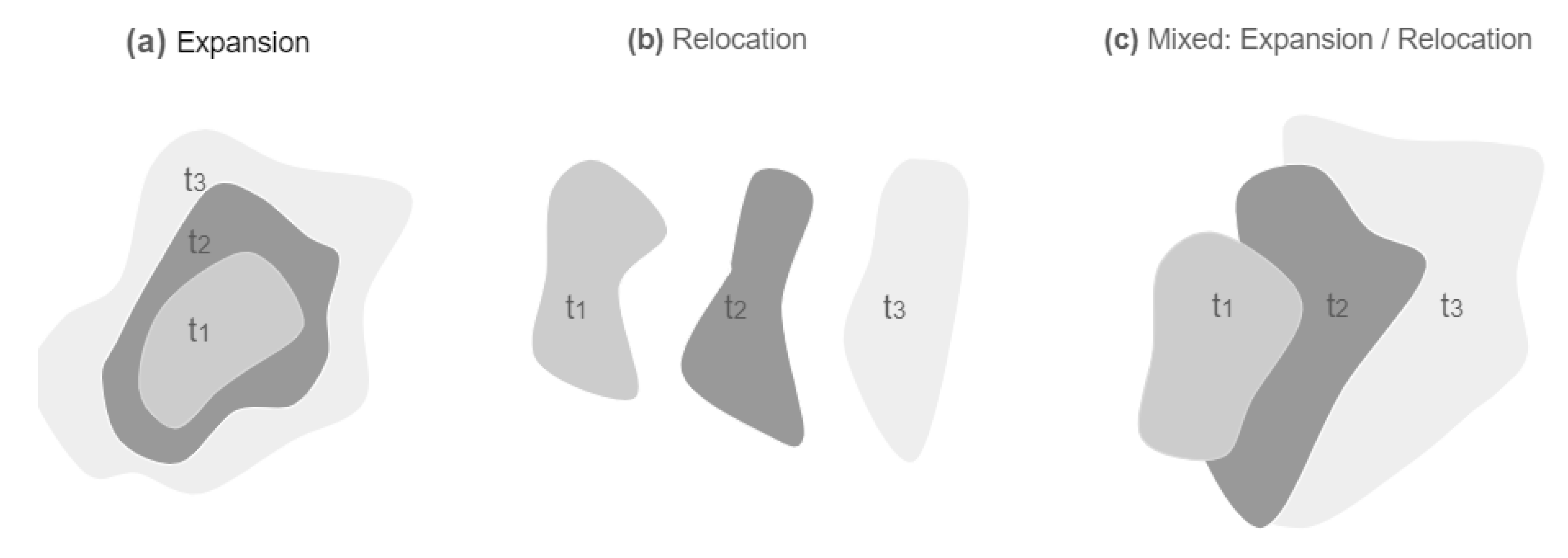

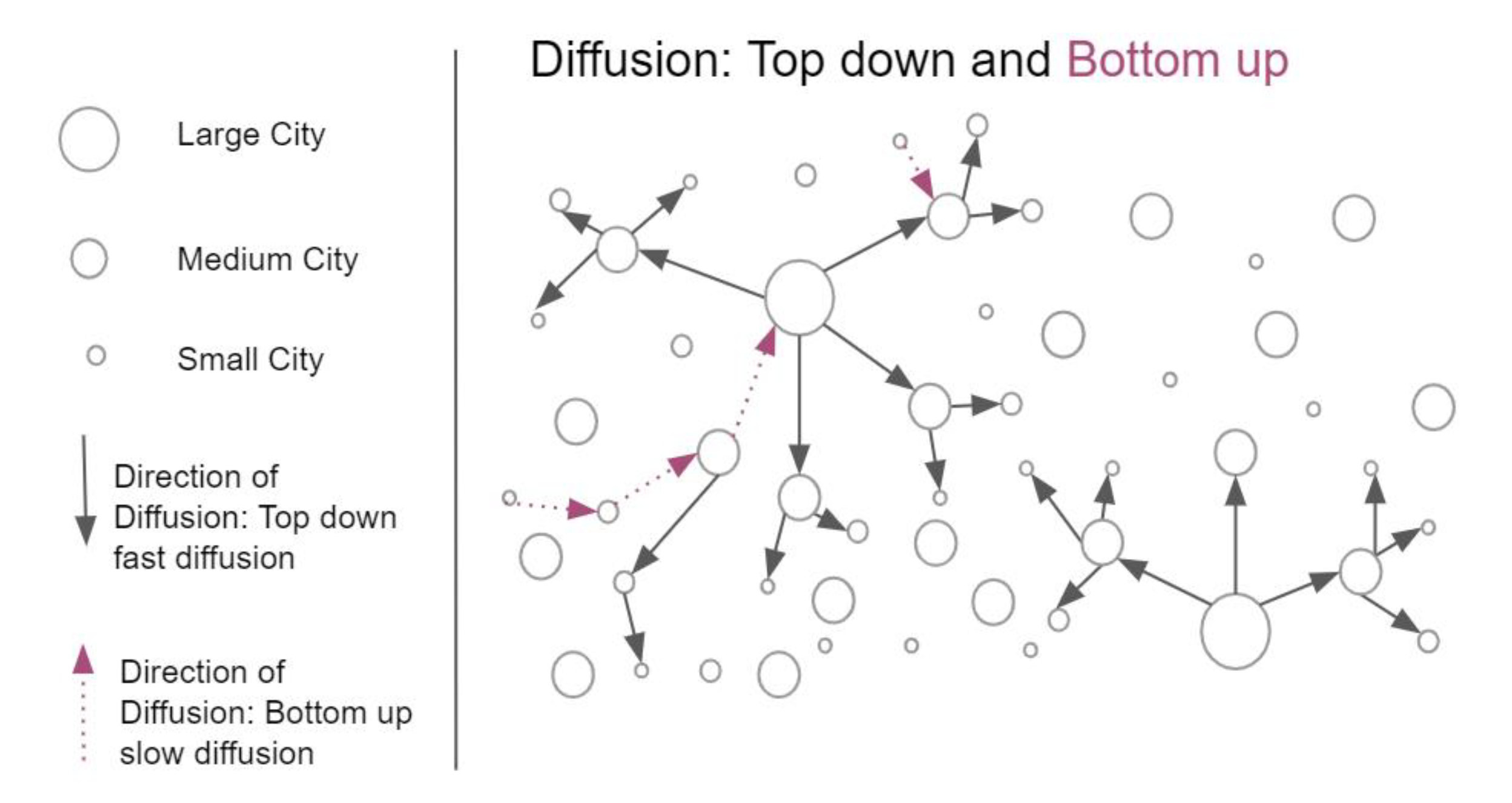

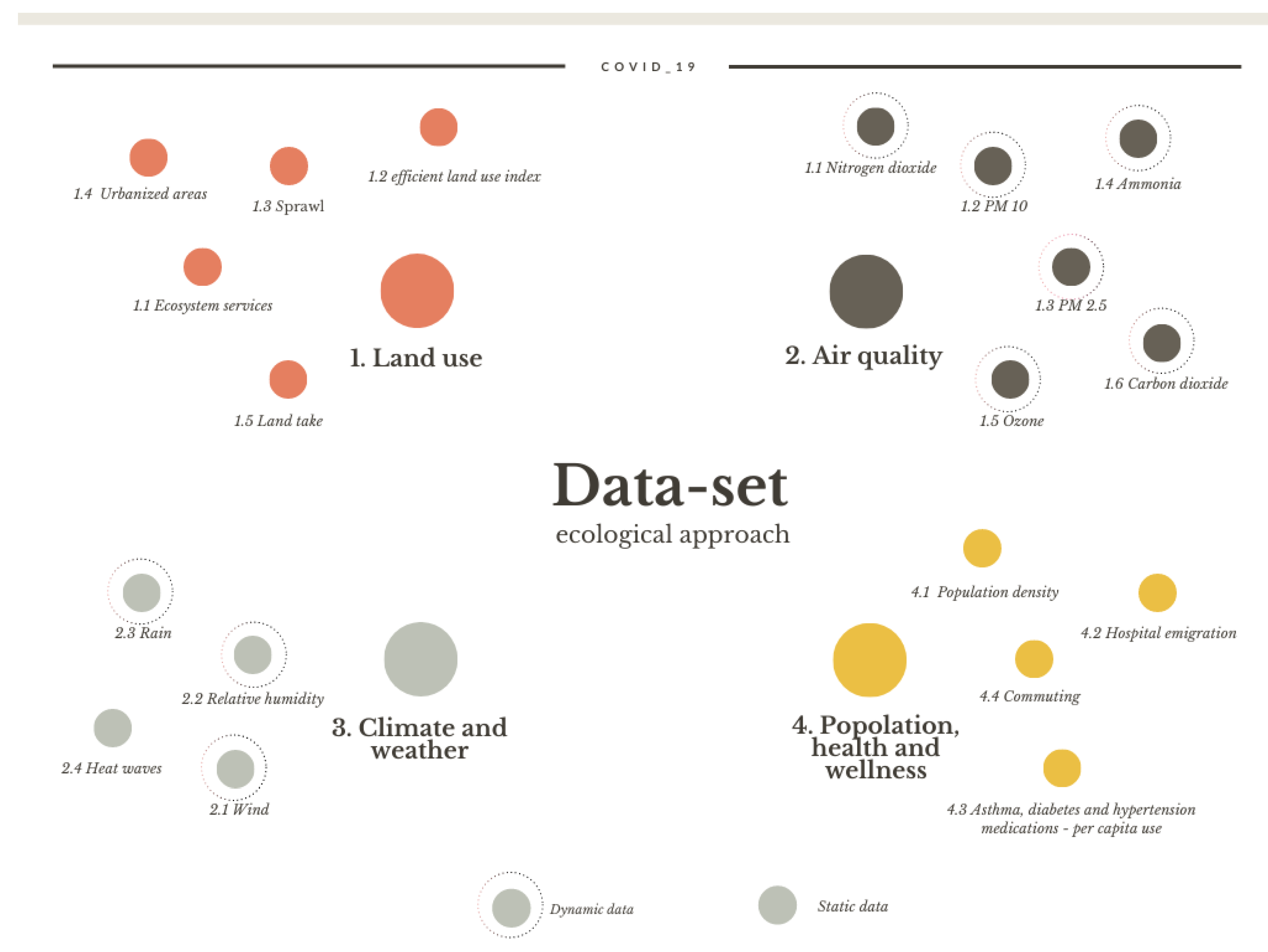
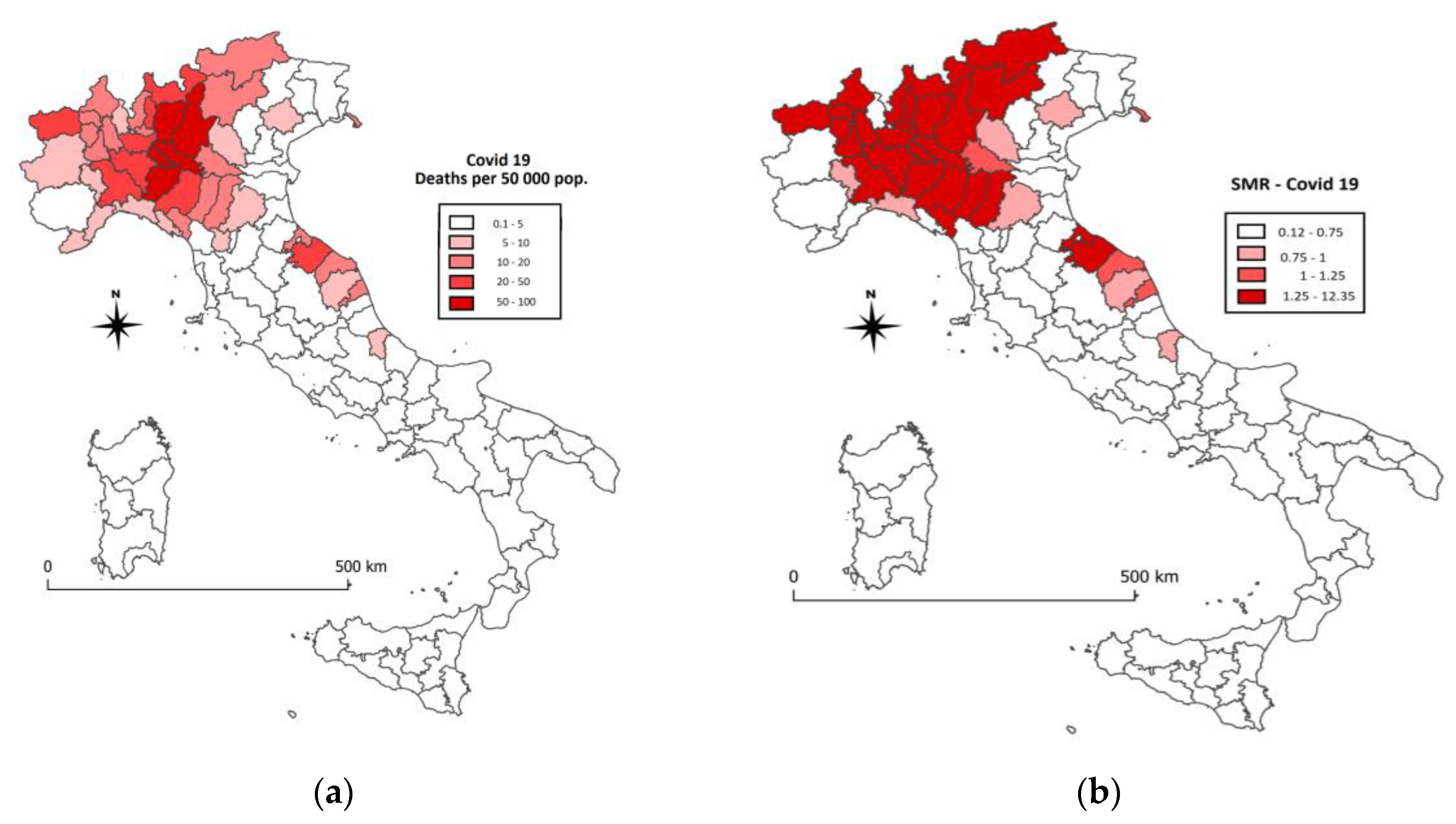
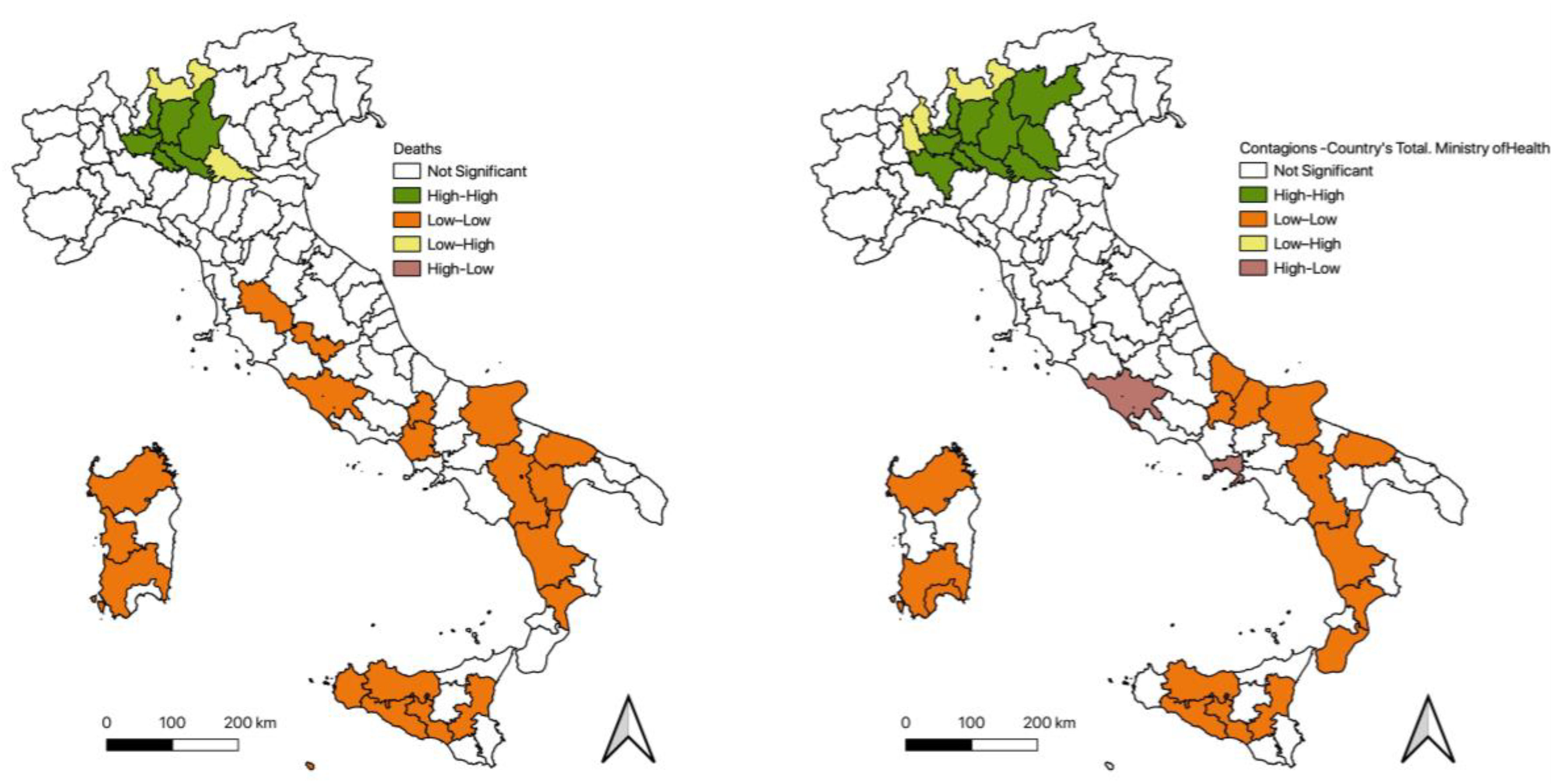
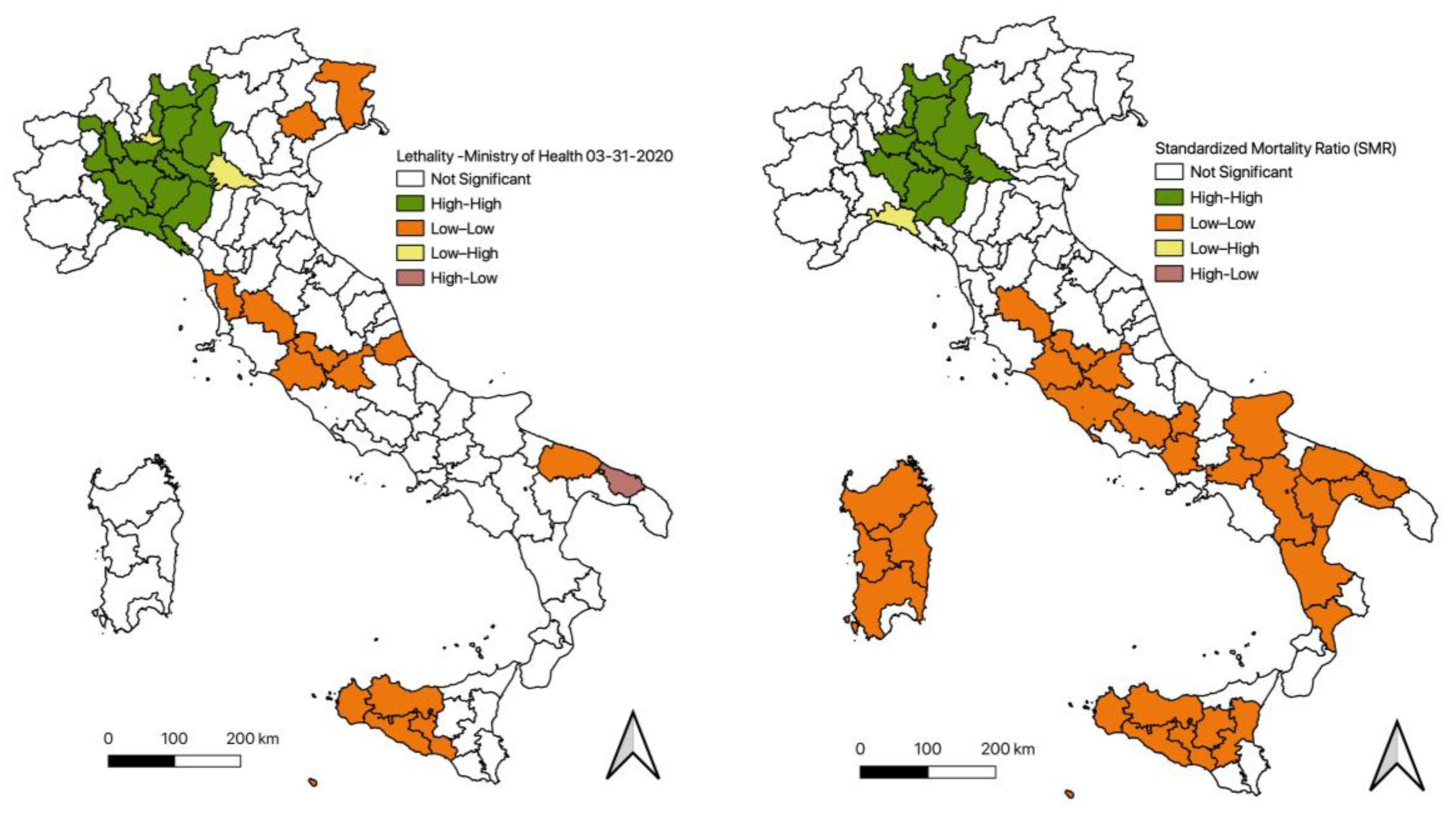
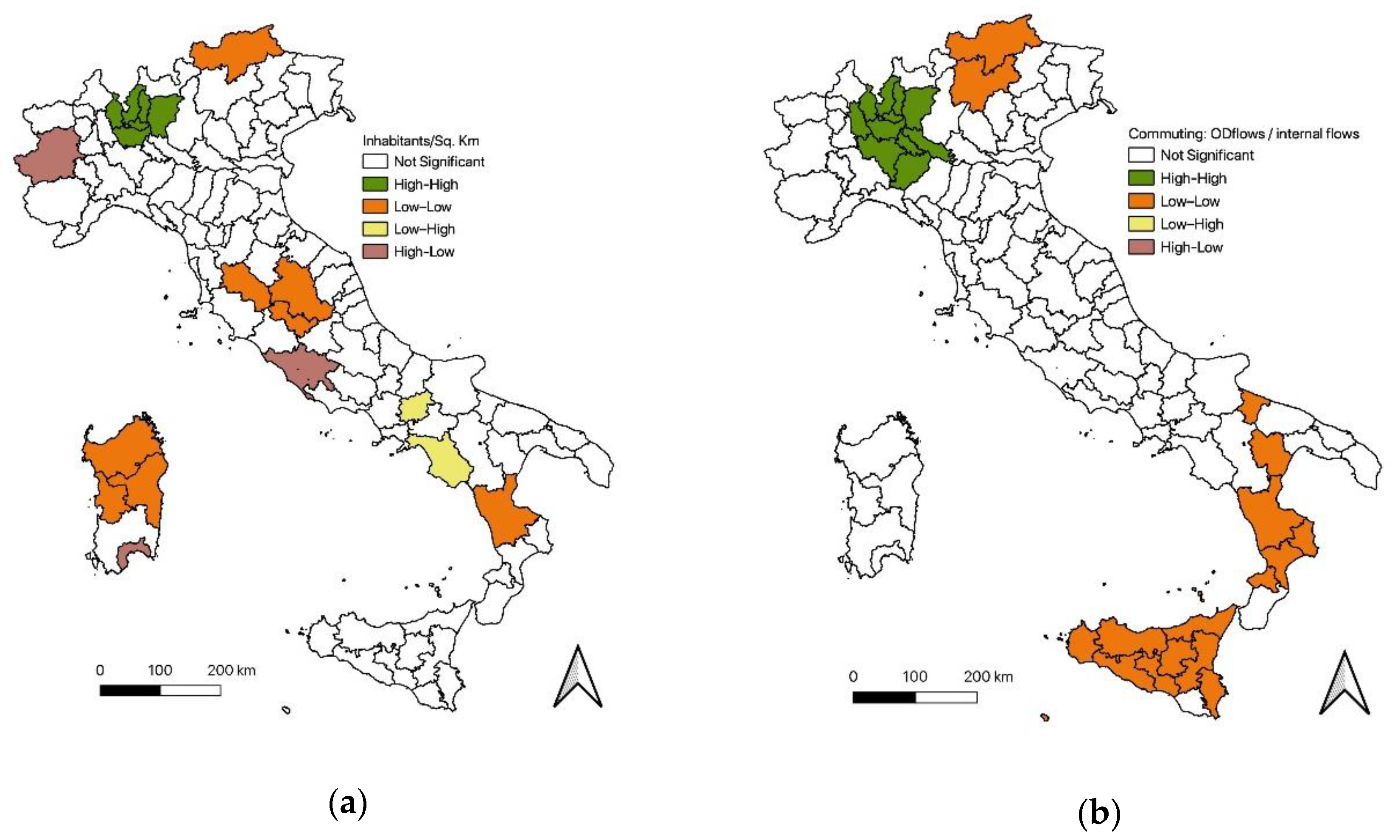
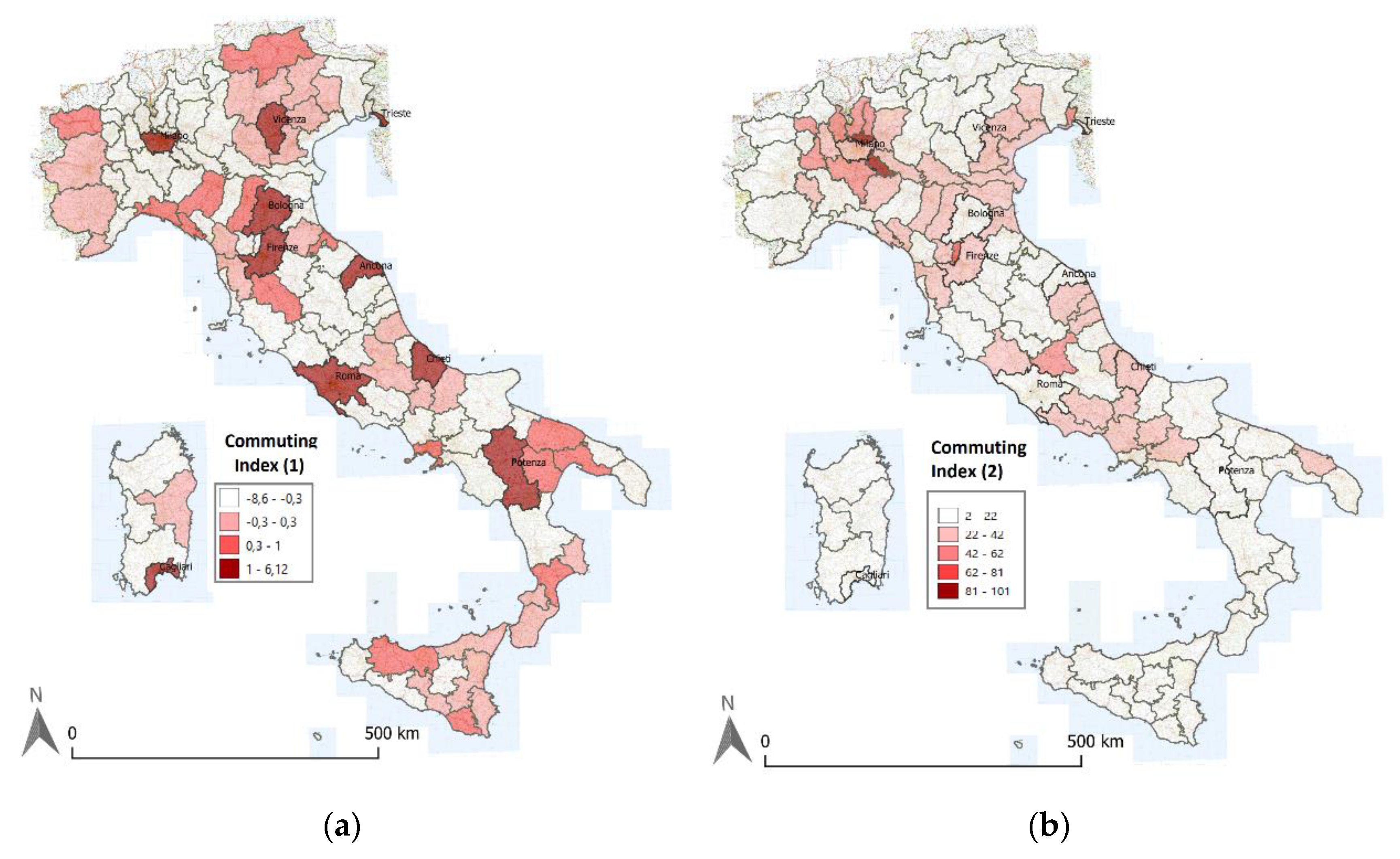

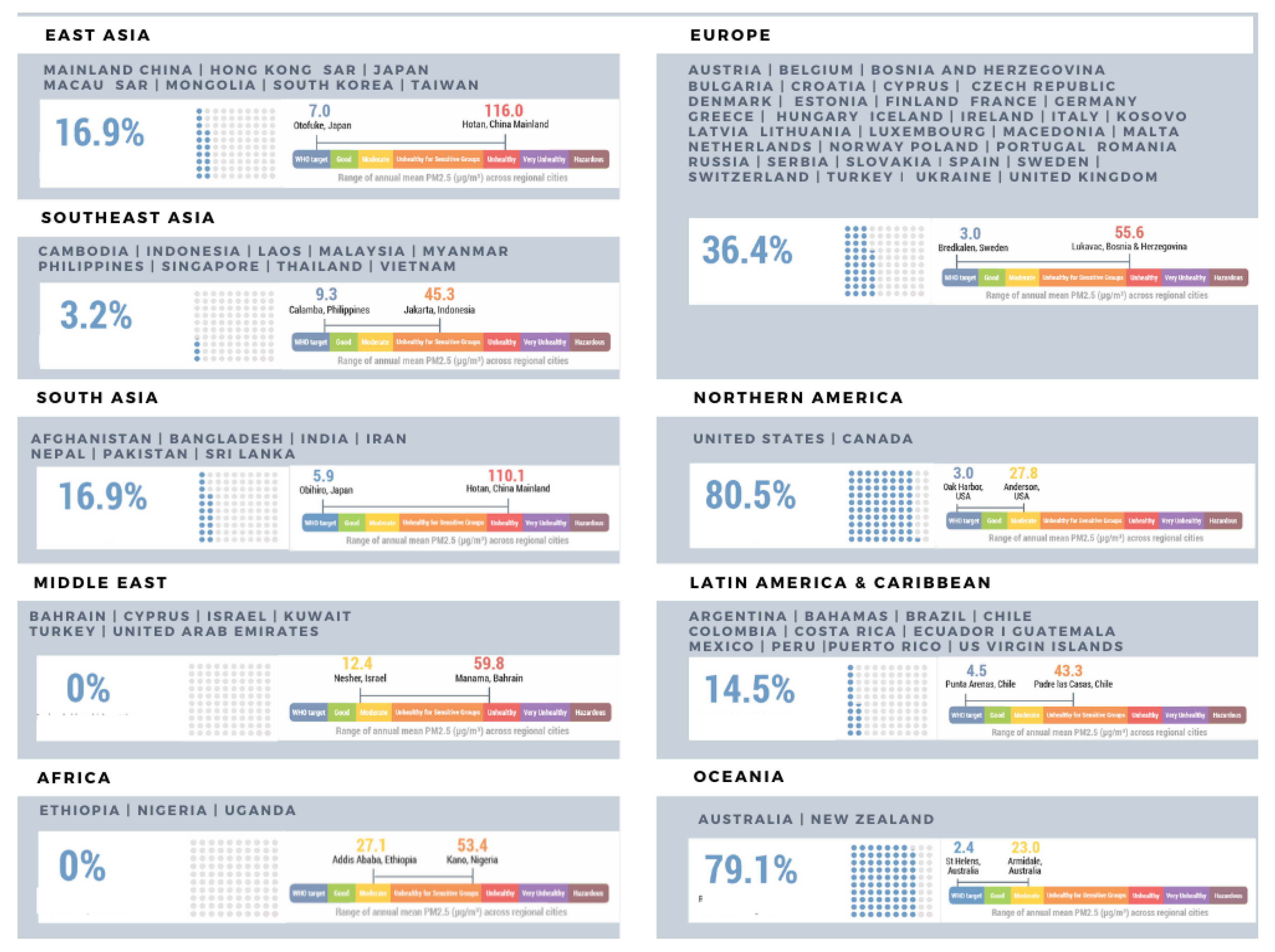
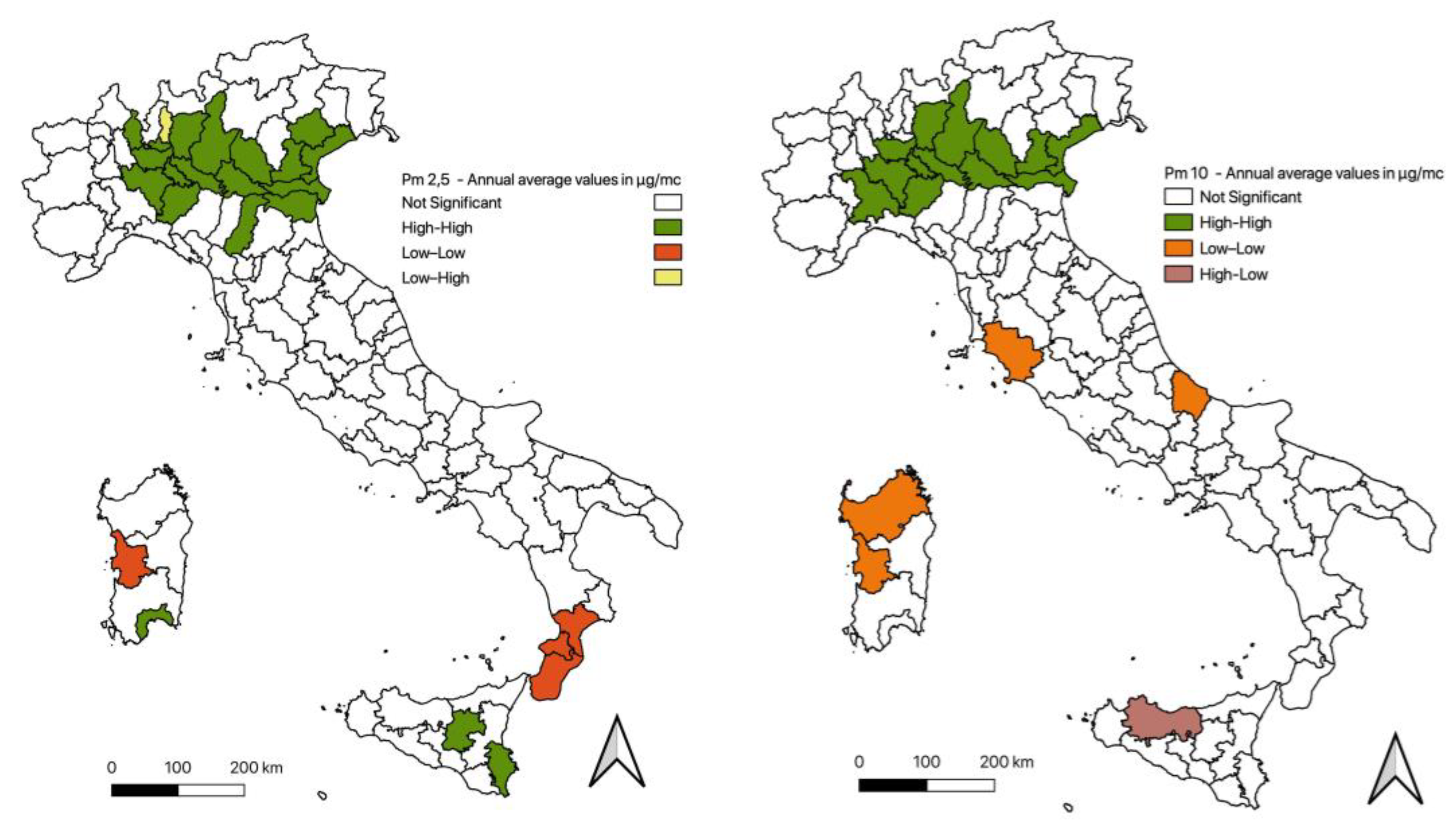
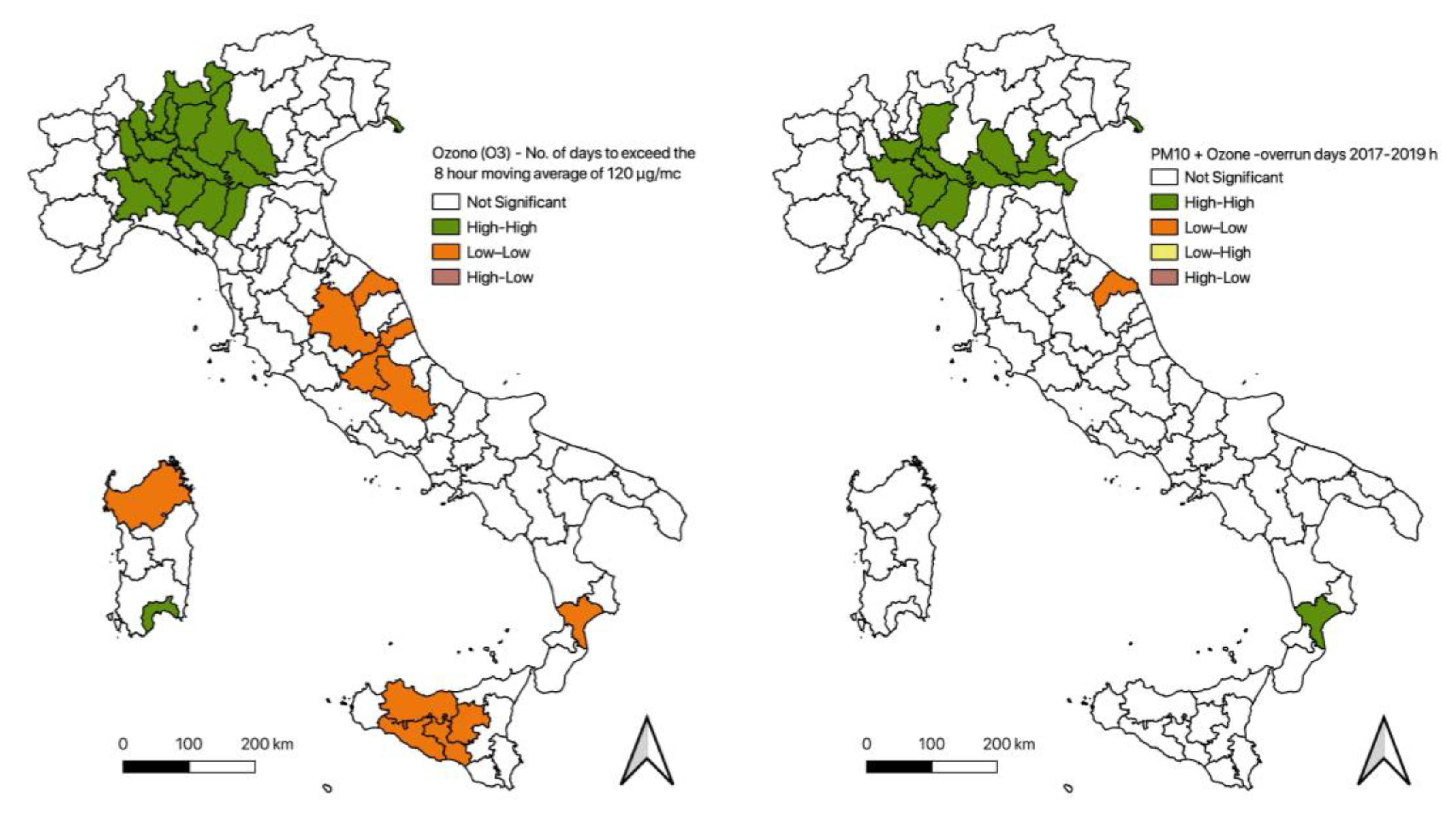
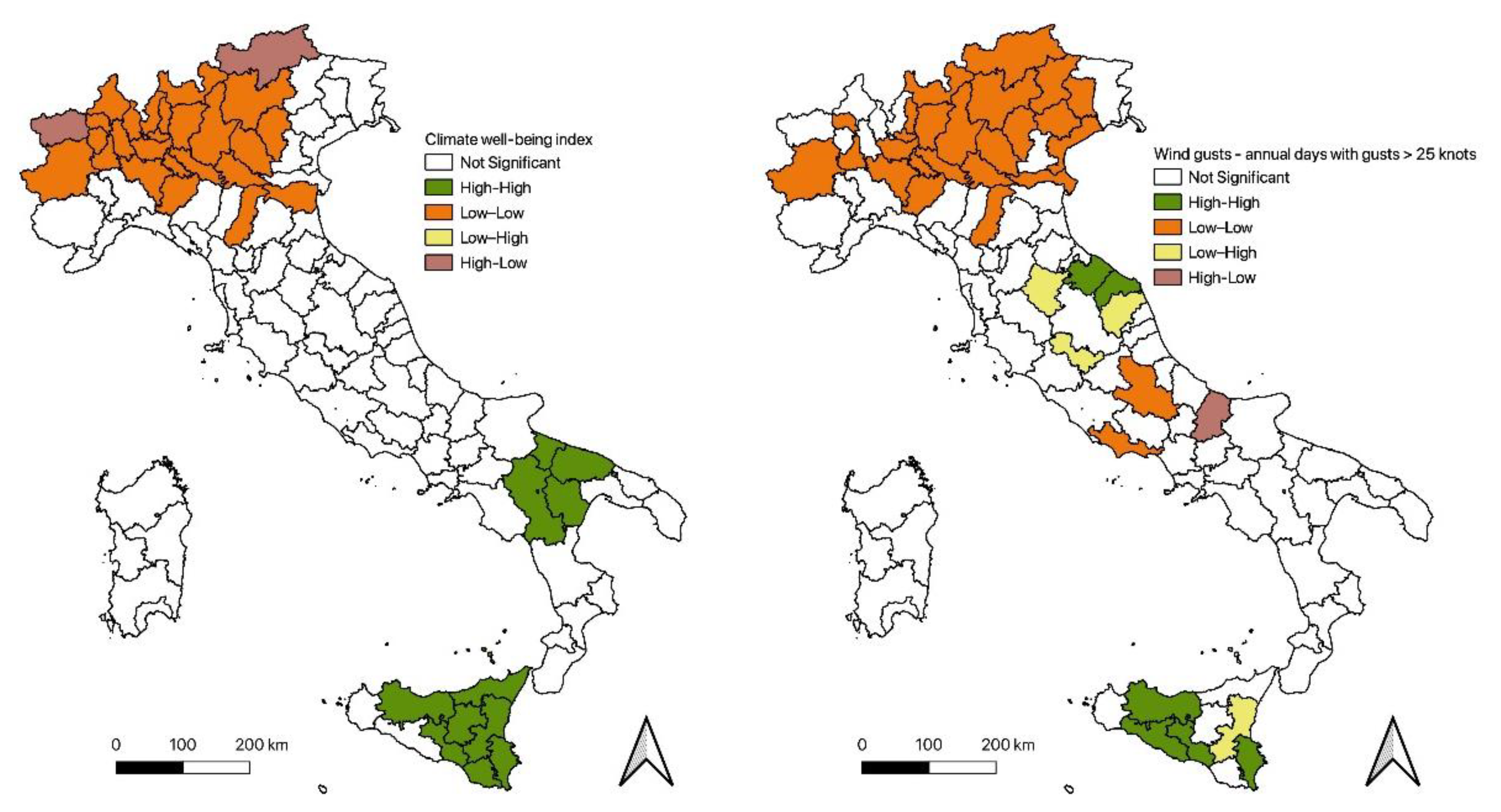
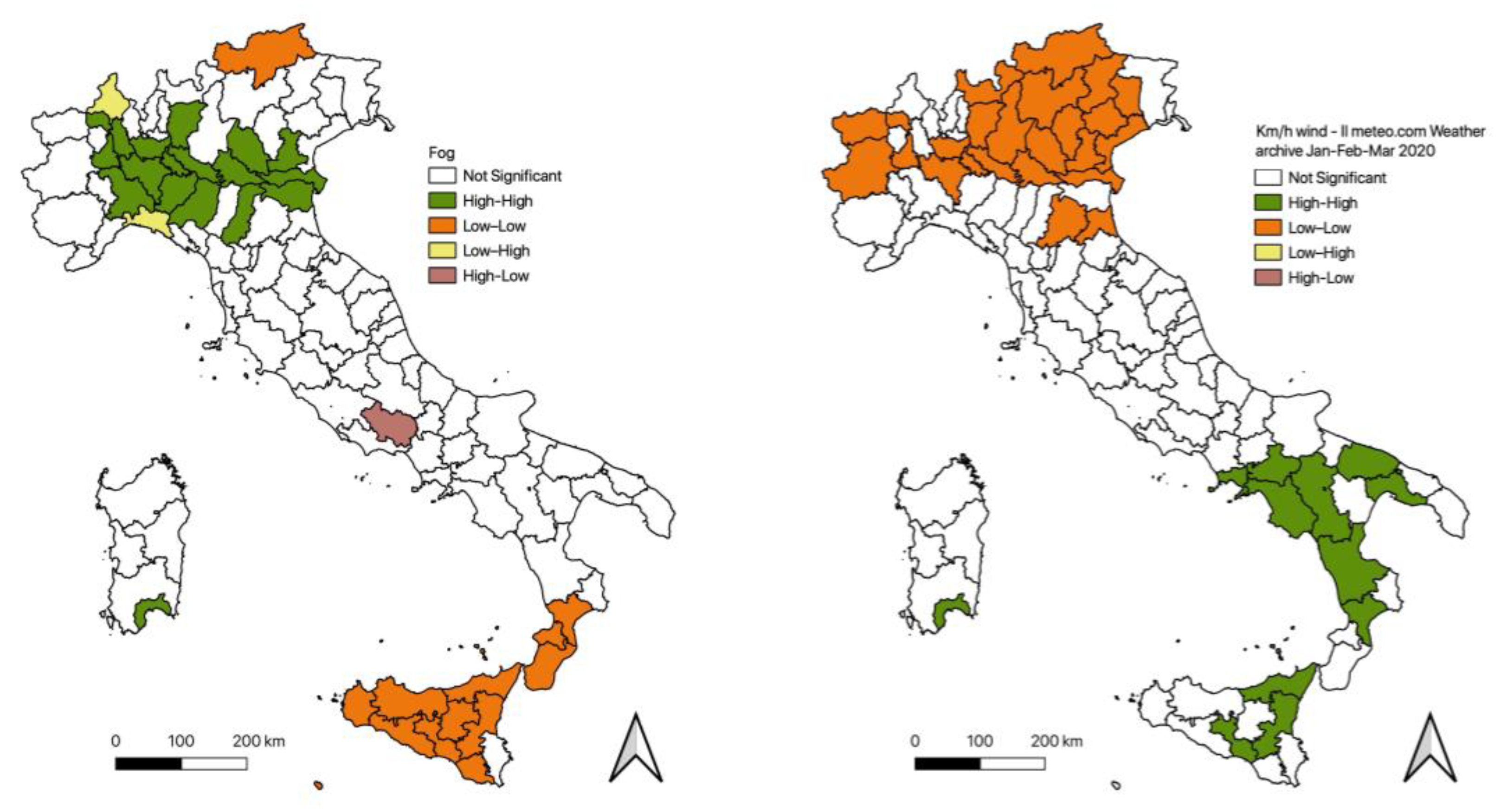
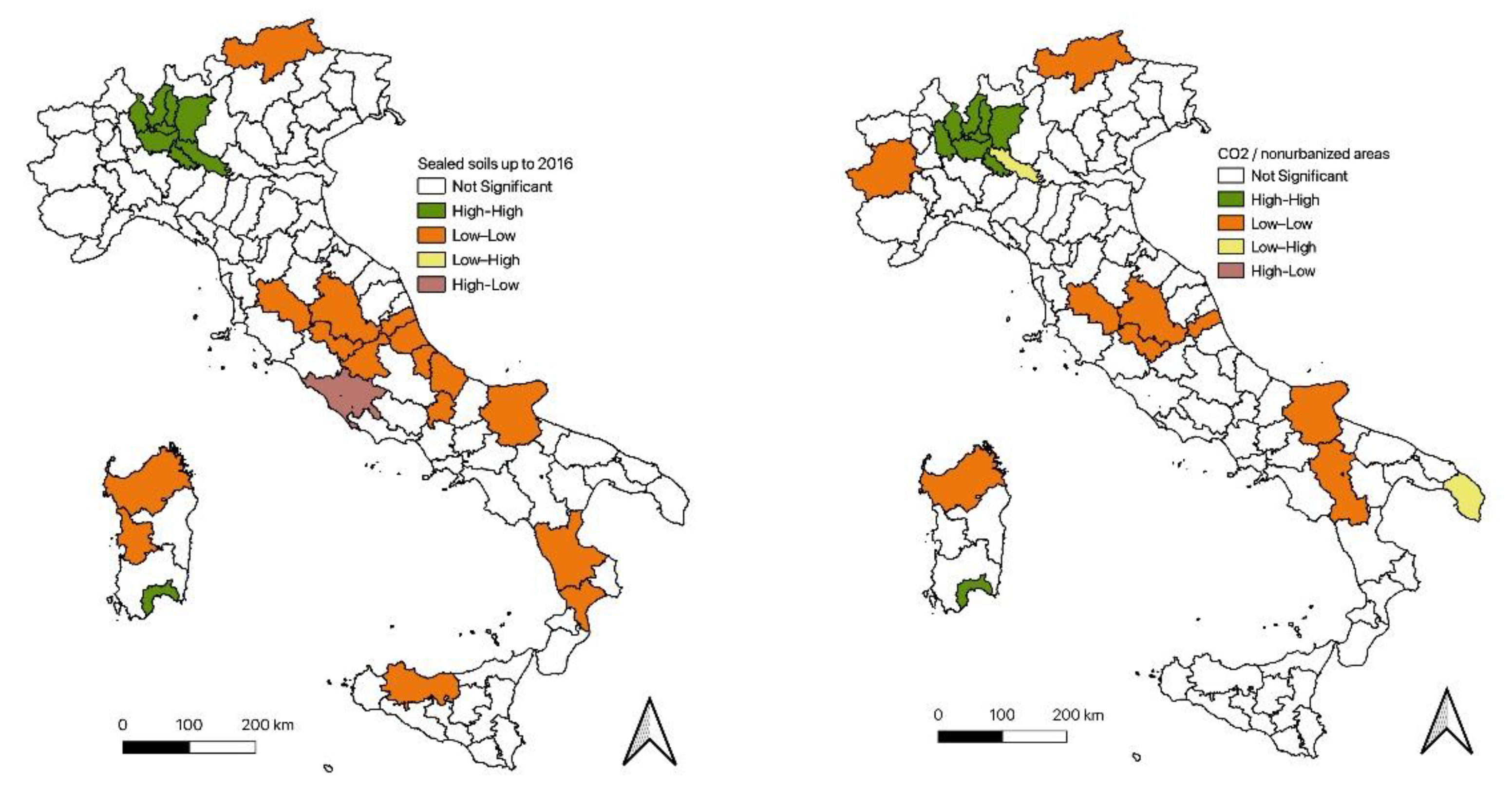
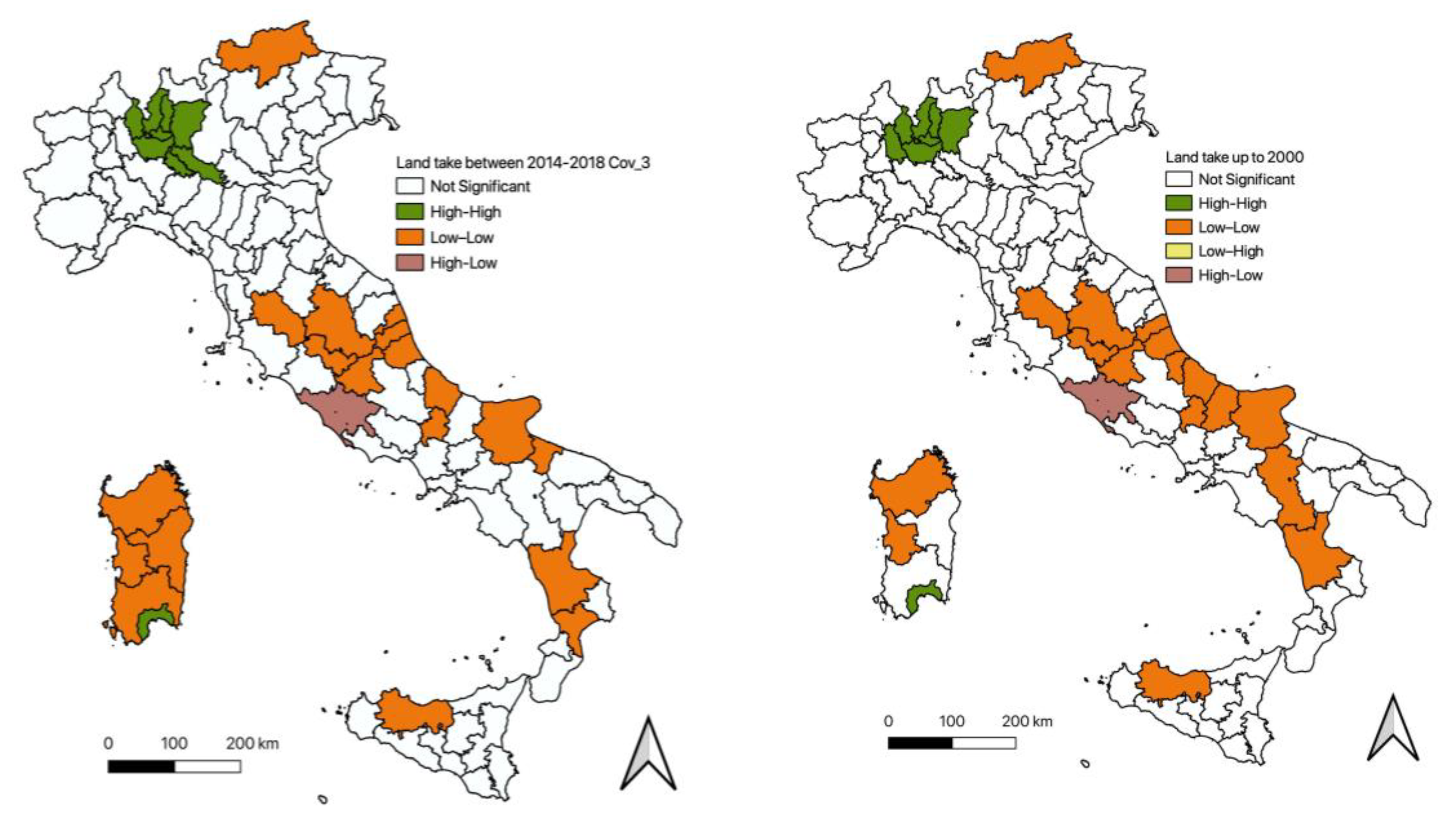
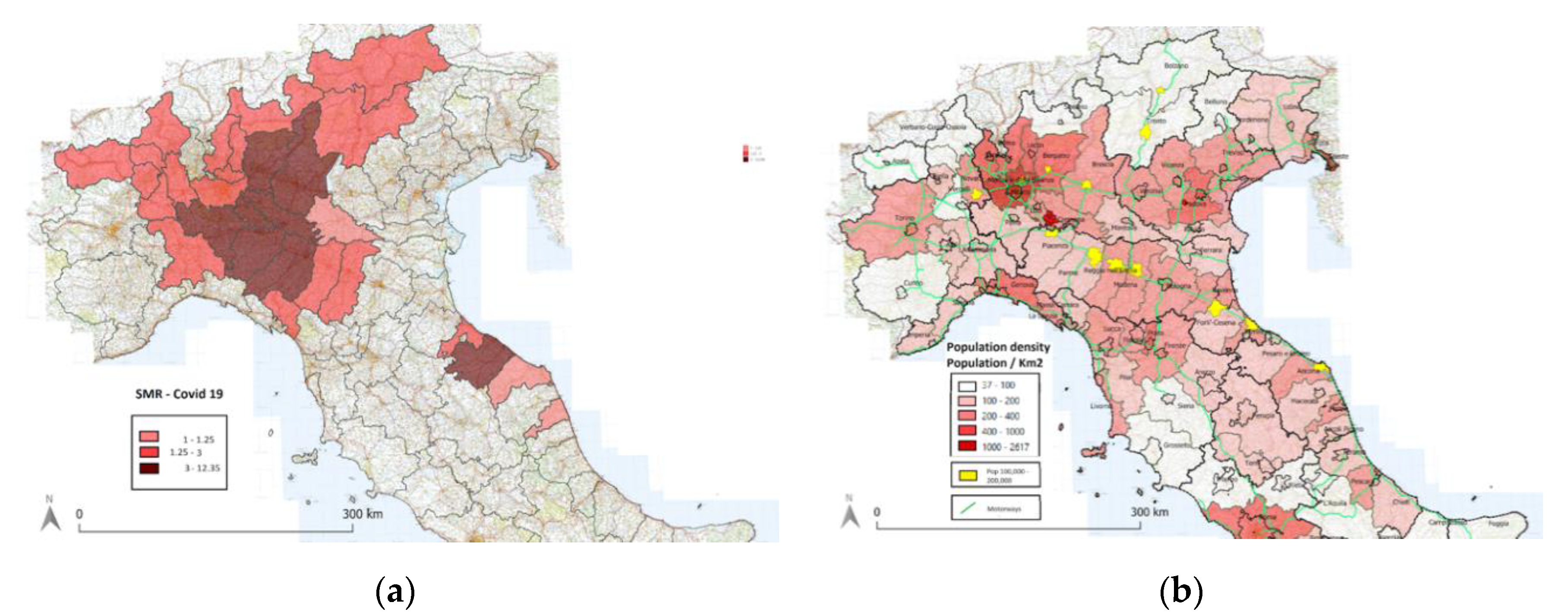
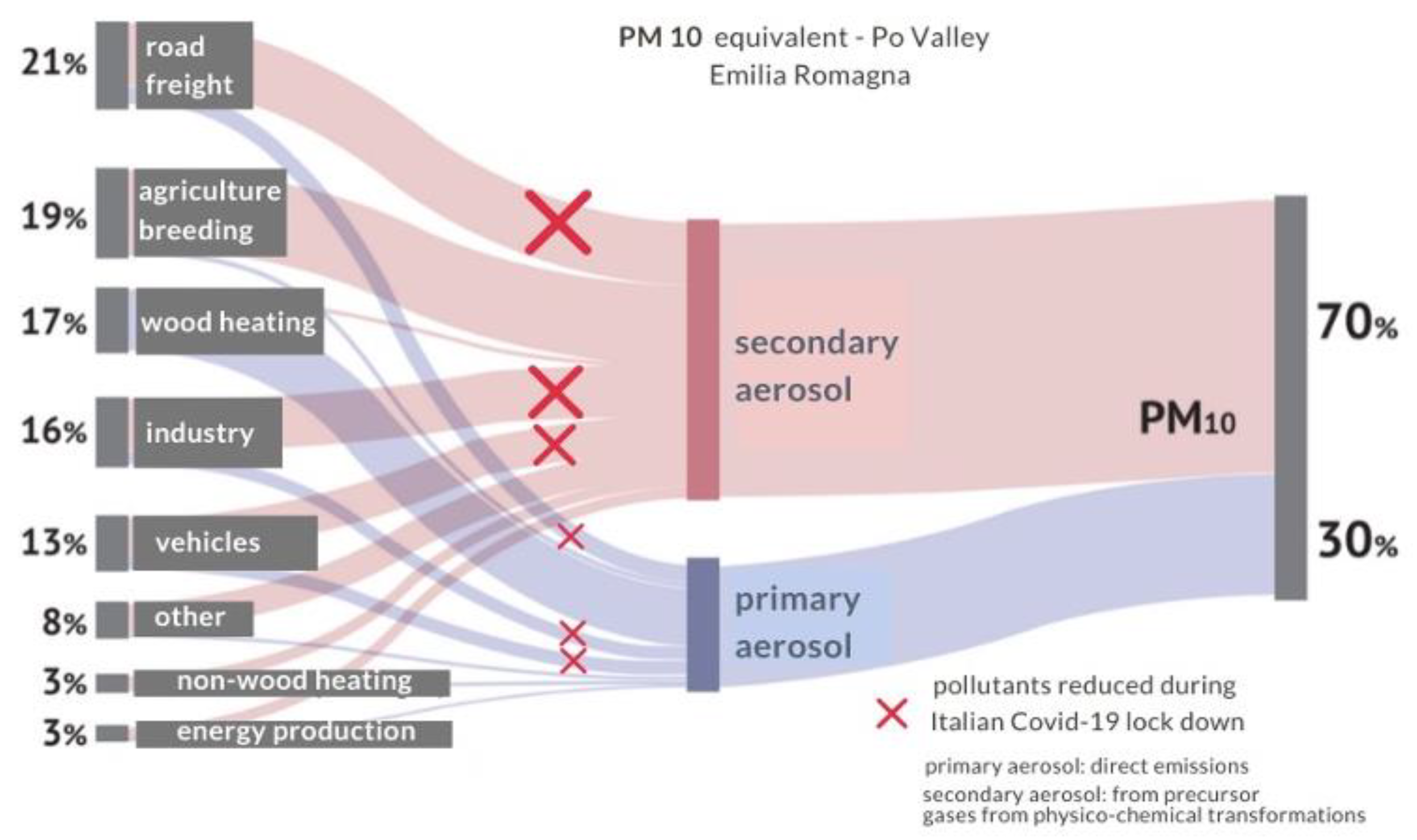

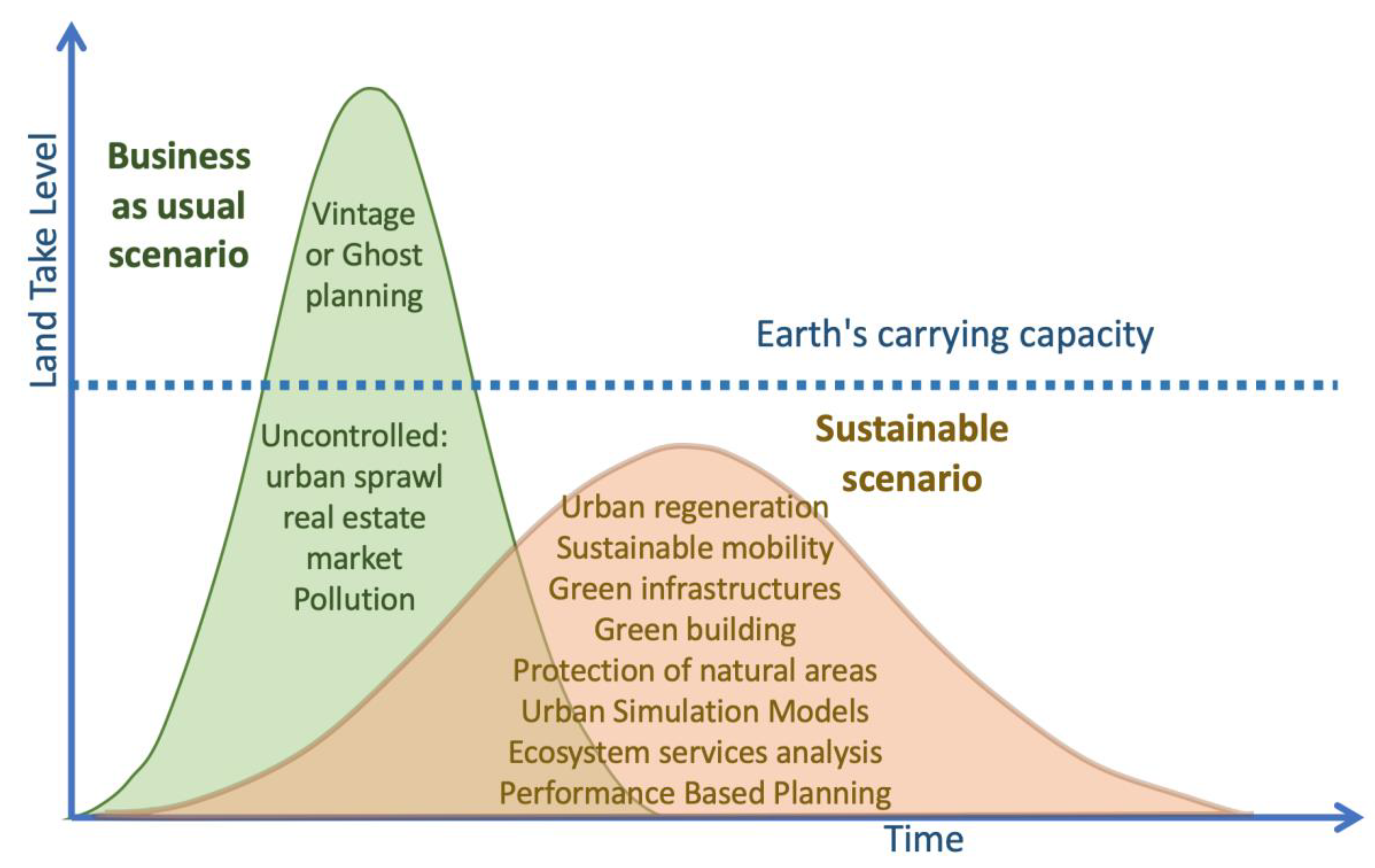
| Province | Population (2019) | Population/km2 | Commuting Index (1) | Commuting Index (2) | SMR | PM10 + O3 * |
|---|---|---|---|---|---|---|
| Bergamo | 1114590 | 404.59 | −1.71 | 22.27 | 12.356 | 349 |
| Lodi | 230198 | 294.01 | −8.6 | 94.66 | 12.262 | 448 |
| Piacenza | 287152 | 111.05 | −0.62 | 23.67 | 10.013 | 299 |
| Cremona | 358955 | 202.75 | −3.94 | 41.76 | 9.583 | 417 |
| Brescia | 1265954 | 264.54 | −0.44 | 12.82 | 7.055 | 401 |
| Pavia | 545888 | 183.89 | −6.91 | 48.91 | 4.751 | 412 |
| Parma | 451631 | 131.01 | 0.79 | 14.62 | 4.494 | 342 |
| Pesaro | 358886 | 139.77 | −0.96 | 14.48 | 4.417 | 0 |
| Sondrio | 181095 | 56.67 | −0.3 | 8.82 | 2.763 | 35 |
| Aosta | 125666 | 38.54 | 0.86 | 6.51 | 2.723 | 61 |
| Milano | 3250315 | 2063.05 | 6.12 | 38.17 | 2.699 | 405 |
| Lecco | 337380 | 418.79 | −3.08 | 56.45 | 2.572 | 282 |
| Reggio Emilia | 531891 | 232.15 | −1.11 | 27.85 | 2.493 | 364 |
| Alessandria | 421284 | 118.38 | −0.48 | 20.36 | 1.974 | 417 |
| Trento | 541098 | 87.18 | −0.18 | 4.62 | 1.892 | 84 |
| Biella | 175585 | 192.26 | −0.57 | 21.04 | 1.857 | 184 |
| Novara | 369018 | 275.34 | −2.13 | 36.33 | 1.686 | 155 |
| Rimini | 339017 | 391.92 | 0.81 | 21.16 | 1.647 | 263 |
| Verbania | 158349 | 70.04 | −0.88 | 13.85 | 1.560 | 45 |
| Como | 599204 | 468.49 | −2.64 | 45.88 | 1.558 | 225 |
| Modena | 705393 | 262.43 | 0.71 | 22.69 | 1.529 | 383 |
| Bolzano | 531178 | 71.8 | 0.4 | 2.31 | 1.441 | 26 |
| Vercelli | 170911 | 82.11 | −1.31 | 52.77 | 1.339 | 82 |
| Massa | 194878 | 168.78 | −2.76 | 37.26 | 1.293 | |
| Monza | 873935 | 2155.69 | −5.98 | 101.24 | 1.255 | 413 |
| Mantova | 412292 | 176.09 | −1.43 | 29.31 | 1.225 | 343 |
| Trieste | 234493 | 1103.48 | 1.34 | 11.96 | 1.211 | 32 |
| Fermo | 173800 | 201.45 | −1.05 | 27.93 | 1.143 | |
| Ancona | 471228 | 240.03 | 1.31 | 15.07 | 1.086 |
© 2020 by the authors. Licensee MDPI, Basel, Switzerland. This article is an open access article distributed under the terms and conditions of the Creative Commons Attribution (CC BY) license (http://creativecommons.org/licenses/by/4.0/).
Share and Cite
Murgante, B.; Borruso, G.; Balletto, G.; Castiglia, P.; Dettori, M. Why Italy First? Health, Geographical and Planning Aspects of the COVID-19 Outbreak. Sustainability 2020, 12, 5064. https://doi.org/10.3390/su12125064
Murgante B, Borruso G, Balletto G, Castiglia P, Dettori M. Why Italy First? Health, Geographical and Planning Aspects of the COVID-19 Outbreak. Sustainability. 2020; 12(12):5064. https://doi.org/10.3390/su12125064
Chicago/Turabian StyleMurgante, Beniamino, Giuseppe Borruso, Ginevra Balletto, Paolo Castiglia, and Marco Dettori. 2020. "Why Italy First? Health, Geographical and Planning Aspects of the COVID-19 Outbreak" Sustainability 12, no. 12: 5064. https://doi.org/10.3390/su12125064









